








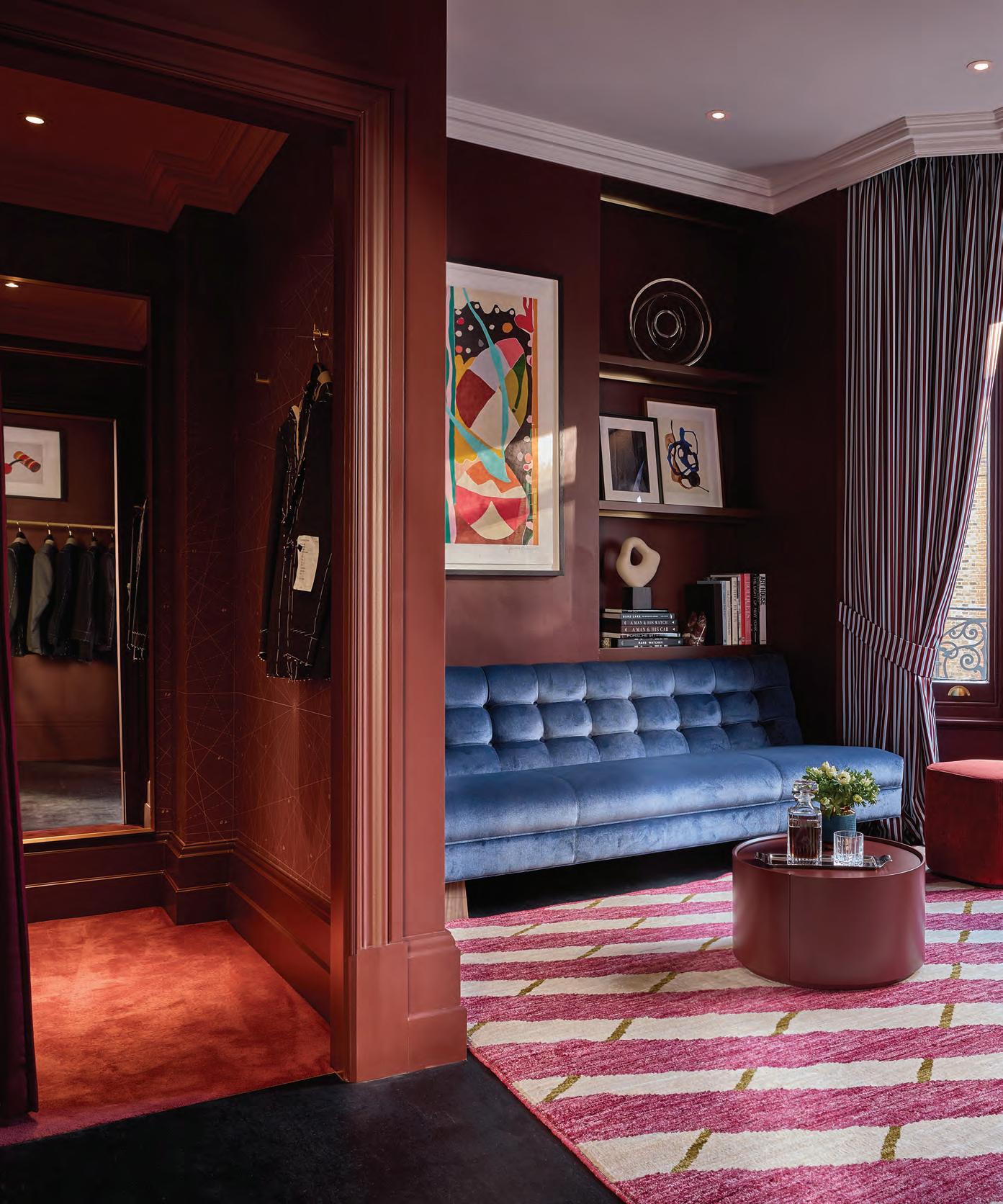
40 THE DAWN OF ANTI-ENTITLEMENT
New York’s silver-spoon kids are waking up with a fresh set of values. Avenue delves into the depths of the new age of teen anti-entitlement enlightenment. By Mike Albo
44 SPRING FLING
Warmer days, shorter nights, and everything in bloom: a season of renewal is upon us. How will you reinvent your wardrobe?
By Natalie D. Kaczinski65 MAD ON DEMAND
In this special section, find a complete directory to everything and anything you may need on Madison Avenue, while historian Gideon Fink Shapiro traces the history of one of New York’s chicest streets.
Between men’s eveningwear and women’s jewelry, everything seems to be relaxing—for better and for worse. BY
PETER DAVIS AND GEORGE HAHNSuperstar chefs Jean-Georges Vongerichten and Daniel Boulud bring their fine-dining flare to the Upper East Side.
BY GEORGE HAHN
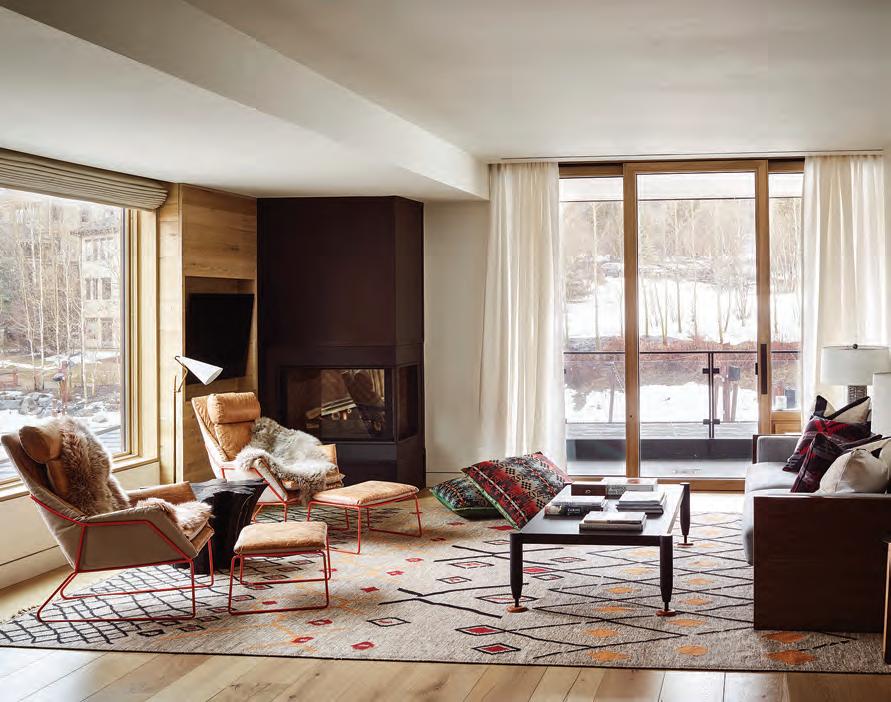
Martin Parr’s photographs have always shone a light on what people wear. But he’s never published a book dedicated entirely to his fashion photography—until now. BY
ARIA DARCELLAThe French art dealer Maëlle Ebelle is director of both Ceysson & Bénétière’s Luxembourg and Upper East Side locations. Our arts writer charts her global reach.
BY ANNABEL KEENANInside four Manhattan powerhouse galleries to visit this spring.
BY ANNABEL KEENANCaldera House, the sleek hotel-cum-members’ club, is at the nexus of everything cool in Jackson Hole.
BY PETER DAVISThe Savile Row design label Richard James, known for its rebellious suits, grows up and moves house, without losing its sense of self.
BY ARIA DARCELLAWith names like Giorgio Armani and Nobu laying their stylish stake on the fabled boulevard, real estate on the strip from 57th to 72nd Street has never been hotter.
BY BETH LANDMANFrom a legendary makeup artist to an emerging fashion brand, these personalities have shaped how we see the city. BY
PETER DAVIS AND GEORGE HAHNThe legendary musician ruled the Carlyle hotel’s social scene for years with his songs. Revisit the man behind the music.
BY CONSTANCE C.R. WHITEJeanne Damas has been dubbed “the Paris girl personified.” She is a fashion designer, a new mom, and stars in the upcoming Disney+ series Kaiser Karl Avenue chats with the woman GQ called “the coolest, most beautiful French girl in France right now.”
BY PETER DAVISATLANTIC CADILLAC BAY SHORE, NY
BICAL CADILLAC BROOKLYN, NY
BROGAN CADILLAC TOTOWA, NJ
BUZZ CHEW CADILLAC SOUTHAMPTON, NY
CADILLAC OF GREENWICH GREENWICH, CT
CADILLAC OF MAHWAH MAHWAH, NJ
CADILLAC OF MANHATTAN NEW YORK, NY

CIOCCA CADILLAC FLEMINGTON, NJ
CROWN CADILLAC WATCHUNG, NJ
D’ADDARIO CADILLAC SHELTON, CT
EMPIRE CADILLAC OF LONG ISLAND CITY WOODSIDE, NY
GOLD COAST CADILLAC OAKHURST, NJ
GRAND PRIZE CADILLAC NANUET, NY
HUDSON CADILLAC POUGHKEEPSIE, NY
INGERSOLL CADILLAC OF DANBURY DANBURY, CT
JOHNSON CADILLAC BUDD LAKE, NJ KING O’ROURKE CADILLAC SMITHTOWN, NY
MALOUF CADILLAC NORTH BRUNSWICK, NJ
MCGUIRE CADILLAC WOODBRIDGE,
PAUL CONTE CADILLAC FREEPORT, NY
PEPE CADILLAC WHITE PLAINS, NY
PINE BELT CADILLAC OF TOMS RIVER TOMS RIVER, NJ
SARANT CADILLAC FARMINGDALE, NY

Madison Avenue is on a winning streak. The majestic boulevard has never been hotter or more stylish. Named in the 1840s after James Madison, the fourth president of the United States, the strip between 57th and 72nd Street is booming with new hotels and restaurants, exciting nightlife, and even more luxury boutiques than ever. Given that we call this corner of Manhattan home, we at Avenue were eager to rediscover one of the chicest streets in the city.
Taking a glance back, Gideon Fink Shapiro revisits the storied history of Madison Avenue, from the boxy, Brutalist Breuer building (onetime home to the Whitney Museum and soon to be Sotheby’s new headquarters), to the Ralph Lauren flagship mansion, a French Renaissance Revival building designed by Kimball & Thompson in 1898. Replete with a ballroom lit by 1,000 lightbulbs, heiress Gertrude Rhinelander Waldo never even moved in to the enormous, extravagant château-like structure that was built for her, choosing to live with her sister in a row house across the street.
Meanwhile, Annabel Keenan checks in on some of the area’s art galleries, Beth Landman scopes out the hotel scene, and George Hahn finds out what superstar chefs Jean-Georges Vongerichten and Daniel Boulud are up to on the UES.
Finally, if anyone encompassed the glamour, glitz, and excitement of Madison Avenue, it was musician Bobby Short. Fashion scribe Constance C.R. White pays tribute to the legendary saloon singer who enraptured Jackie O., the Duke and Duchess of Windsor, and Frank Sinatra for years at the Café Carlyle. Allal Gogo, the café’s general manager, tells Avenue that “there are a lot of regulars who still come into the Carlyle because they want to remember the memories of Bobby.”
As Short sang of New York: “I like the city air, I like to drink of it/The more I see of New York, the more I think of it/I like the sight and the sound and even the stink of it/I happen to like New York.”
We could not agree more.
See you on Madison,
PETER DAVIS Editor-in-ChiefLike and follow us at @AVENUEinsider
Sign up for our weekly newsletter at avenuemagazine.com
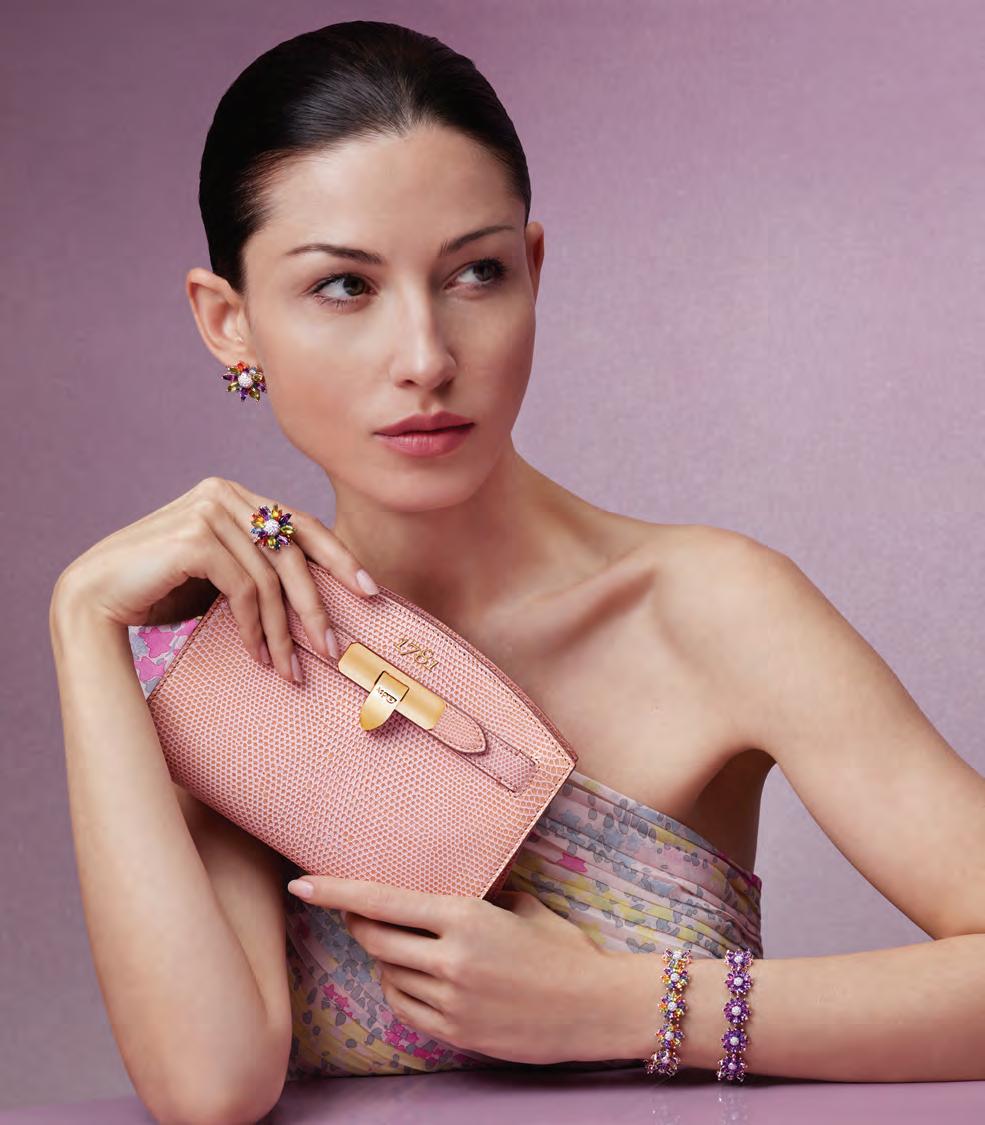
 THE 1781 HANDBAG COLLECTION
THE DAISY JEWELLERY COLLECTION
THE 1781 HANDBAG COLLECTION
THE DAISY JEWELLERY COLLECTION

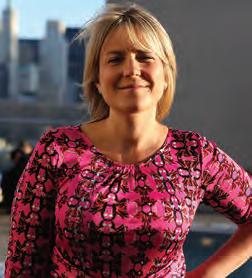
Mike Albo (The Dawn of Anti-Entitlement, page 40) is a Brooklyn-based writer and performer whose most recent novel, Another Dimension of Us, comes out in paperback this spring. For this issue, he wrote about how to avoid raising kids with a sense of entitlement. “So many parents I know who worked hard for their money told me (off the record) how worried they are that their kids will never understand struggle,” he says. “But like everything in this city—there’s a therapist for that!”
Jill Carvajal is a New York-based advertising expert who helped build the New York Post’s website (including a spinoff for Page Six), and launched Front Row Communications, which counts everything from William Morris Endeavor to Nexstar Media Group as clients. This year, she joined Avenue as a publishing consultant. “Avenue’s evolution to connect with today’s influencers aligns perfectly with my passion for bridging tradition and contemporary trends,” she says. “What excites me the most is how my daughters now see me as ‘cool’ for being part of a publication that unveils the real faces behind Manhattan’s societal scenes.”
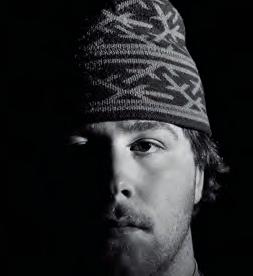
Chadwick Hildner (Your Own Private Wyoming, page 54) is a Colorado-based photographer who has created short films and content for the Guide Network, a fly-fishing company. An avid skier, he knew what to look for when shooting the Caldera House resort in Wyoming.
“I’ve skied Jackson Hole countless times,” he says. “The Caldera House is just what [it] needed. At the end of the day there is nothing better than being able to drop your skis off at the base of the mountain and head in for a drink.”

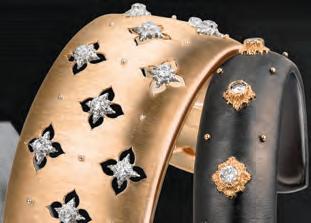

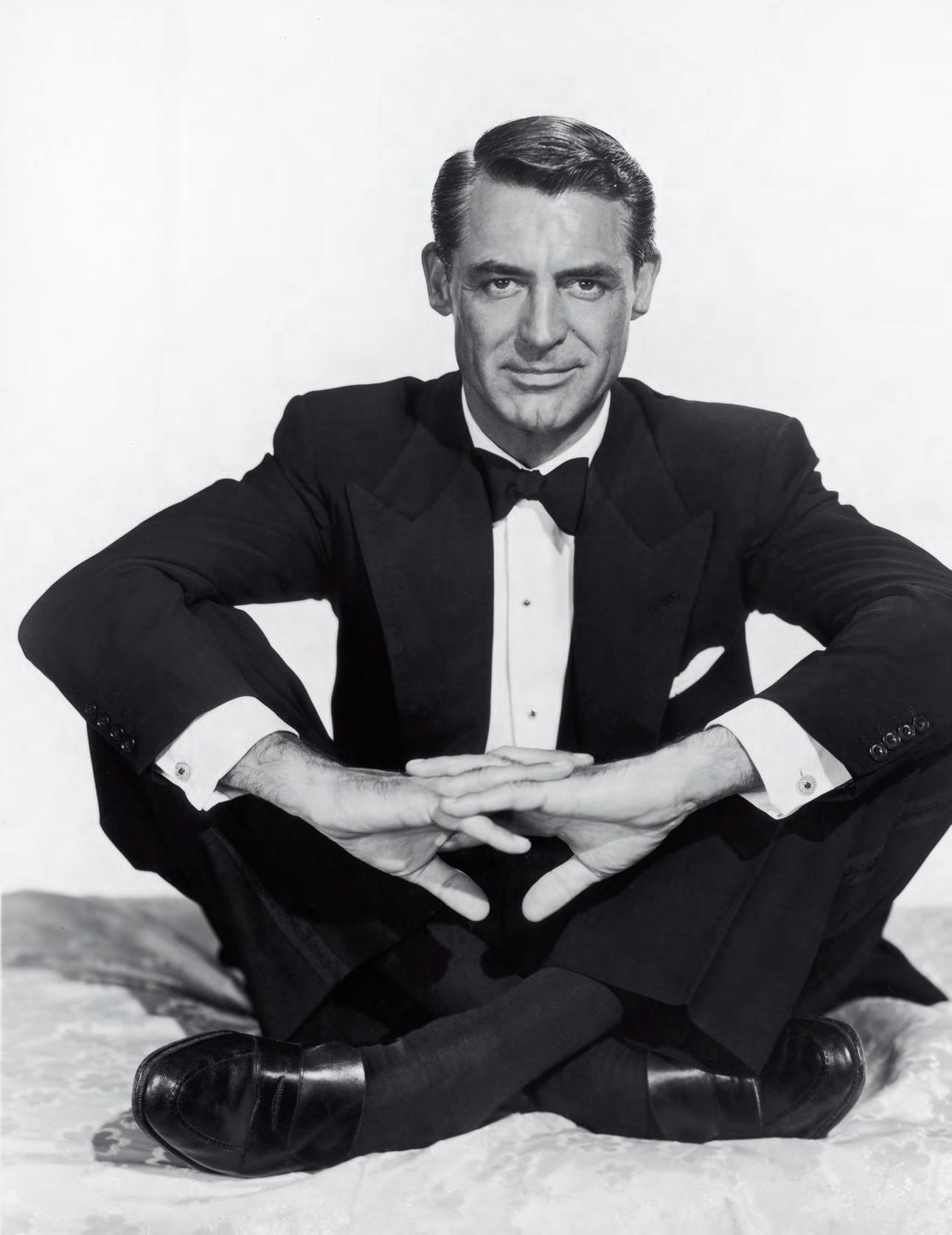
Between the Patagonia fleece vests donned by finance bros on Wall Street and the shlubby hoodies of Silicon Valley, it is a sad state of affairs putting grown men into soft, shapeless, sexless, uninspired, adult-size toddler clothes.
Iwas recently walking up Central Park West on a beautiful night in New York when I suddenly started seeing people in black tie. As I got closer to West 77th Street, it became clear that the venue for this formal event was the Museum of Natural History, from which people were exiting onto the streets in exquisite gowns and handsome tuxedos. It was glorious.
Wearing black tie has become increasingly rare, even on red carpets, where young celebrities and the freshly Insta-famous have abandoned classic black tie for bolder, more avant-garde ensembles. Timothée Chalamet, Riz Ahmed, and Pedro Pascal’s attire may be entertaining, chic, and boundarypushing now, but they risk looking dated after a few years. Time will tell. And yet, when we look at old photos of men in their tailored dinner jackets from decades past, we still admire how good they looked. Why? Because the tuxedo is the perfect uniform, masterfully designed to make every man look his absolute best.
Meanwhile, at the office, we’re in a hyper-casualized place in which men fear, or even demonize, the idea of dressing up or looking too nice. Have you noticed that the necktie has gone into the witness protection program, even among television news anchors? Between the Patagonia fleece vests donned by finance bros on Wall Street and the shlubby hoodies of Silicon Valley, it is a sad state of affairs that is putting grown men into soft, comfy, shapeless, rubberized, sexless, uninspired, adult-size toddler clothes. Our younger men are having difficulty attracting mates today, and our endangered sense of occasion and overall allergy to looking nice isn’t helping.
Perhaps this trifling piece is a call to arms. A call to raise the sartorial baseline. A call to go full black tie, which is the evening uniform in which
every man—no matter what he looks like—looks fantastic. As the late inimitable style authority Glenn O’Brien once wrote, black tie “is as close as a civilian gets to the uniform of a hero. Wear it proudly.”
And when we go black tie, let’s do it right. Ditch the half-assed tux with notch lapels, which is just a black business suit with shiny lapels, or a black necktie, which just makes one look like a chauffeur or a pallbearer. Instead, don a real dinner jacket with a peak lapel or a shawl collar, in black or midnight blue (or ivory in tropical modes). Black tie is not the place to experiment or get creative out of boredom or a desperate need for attention. If you’re worried about being memorable, just don’t forget to bring your face and your personality to the party.
When an invitation says “black tie optional,” it means that the hosts would prefer their invited guests to wear black tie. Since they’re going through the trouble of throwing a nice party with free food and drinks and possibly some live music in a glamorous setting and, last but not least, inviting us to said affair, let’s not be shy about dressing up.
And why wait for an invitation to a formal event? Why not create a reason, or just do it for no reason? Going to a Broadway show? The opera? Or just dinner with friends? Make it a black-tie affair, just for the hell of it. The worst thing that could happen is that you might look like an old Hollywood movie star or a member of the Rat Pack. Or you might turn a lot of heads and get a lot of compliments because you look so damn good.
Or is that the best thing that could happen? Let’s find out.–GeorGe HaHn
In 1960, Laurence “King of Diamonds” Graff founded his eponymous company. Since then, it has grown to become one of the most important diamond brands in the world. Just last year, it opened its ninth location in the United States—in Costa Mesa, California. To crown the boutique, the brand used it to display an impressive diamond necklace weighing a total 150 carats, with an extraordinarily rare 50-carat flawless oval diamond at its center. It’s a gorgeous piece that speaks to the house’s heritage as a purveyor of decadently designed haute bijouterie
It’s surprising, then, that in recent months Graff has been promoting a line of gems a little more down to earth.
“For years—decades, even—we focused on the most extraordinary large jewels as our core DNA and as our primary business operation,” says Marc Hruschka, CEO and president of Graff USA. “We had many of our amazing clients requesting items that were appropriate for gifts for nieces,

nephews, daughters, for bat mitzvahs, et cetera, and we consistently had to turn them away.”
Meeting the demand turned out to be an easy decision to make. The Graff family decreed that as long as the design—and the handling of the stones—was done by Graff, size was irrelevant.
Featured in the line are the “Butterfly” collection, a dainty set featuring the insect motif, and the “Tilda’s Bow” collection, which is inspired by Laurence Graff’s bond with his granddaughter. The creation of both is held to the same standards as Graff’s most extravagant pieces.
“Quality parameters stayed the same, which are the best in the world,” confirms Hruschka. “We go through many iterations before deciding on what is the right version, which means it’s the most wearable and it reflects the brand ethos at a level that we expect. For the design team, it’s
been an opportunity to showcase the skill set beyond one-of-a-kind designs. It presents the challenge of creating items that are going to get some wear and tear.”
As with all collections, the Graffs themselves were heavily involved with the design team. It’s a surprisingly humble touch for a company with such a wide reach. “We have a very personal feeling to our stores and that comes directly from our owners,” says Hruschka. “They’re as involved as they were from the very start of the company, and that’s a gift.” —Peter
Davis GEM PALACE Graff’s New York boutique.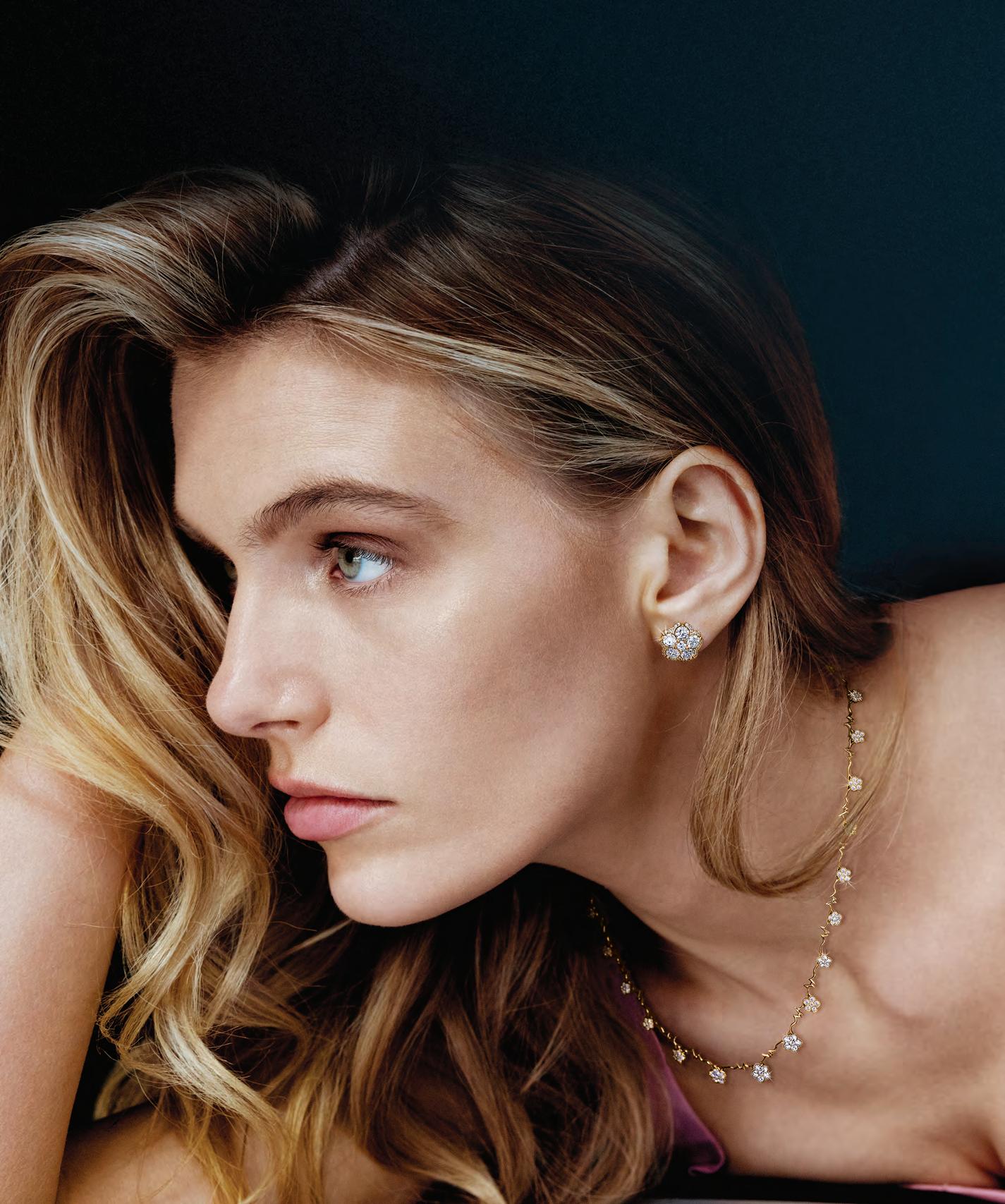

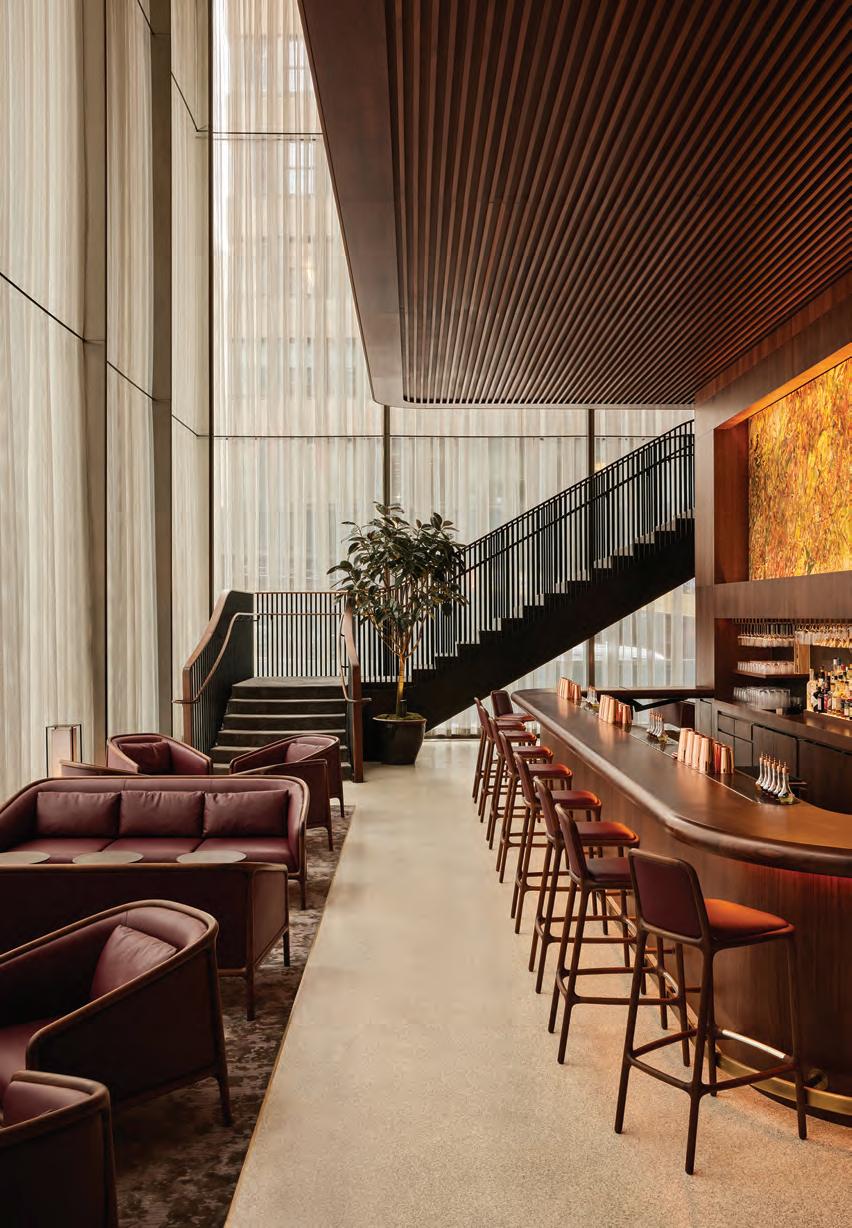
Superstar chefs Jean-Georges Vongerichten and Daniel Boulud bring their fine-dining flair to the Upper East Side. George Hahn digs in.
Nested discretely on the ground floor of the new Foster + Partners office tower on the corner of Park and 56th Street is the latest jewel in Jean-Georges Vongerichten’s Manhattan crown: Four Twenty Five.
Like a private club, the entrance is unmarked and brings you into the handsome street-level bar and lounge. Men in suits crowd the long bar, fetching drinks for their dates who lounge on sofas near the 45-foot floor-to-ceiling windows framing the Park Avenue nightscape. The room is— to put it simply—sexy. As you drink in the scene, including the 24-foot painting Hunch by Larry Poons hanging above the bar, you may reflexively utter the word “Wow,” quickly followed by, “This place is chic.” Go with it, because it is.
A stunning staircase fit for a mid-century modern remake of Auntie Mame leads guests up from the bar to the mezzanine dining area.
The dining room feels like a warmly lit glass jewel box, with windows draped in sheer curtains on three walls and the fourth featuring an open view to the immaculate kitchen. It’s an elegant space. If there isn’t a dress code, it certainly feels like there should be. This is a place with a sense of occasion.

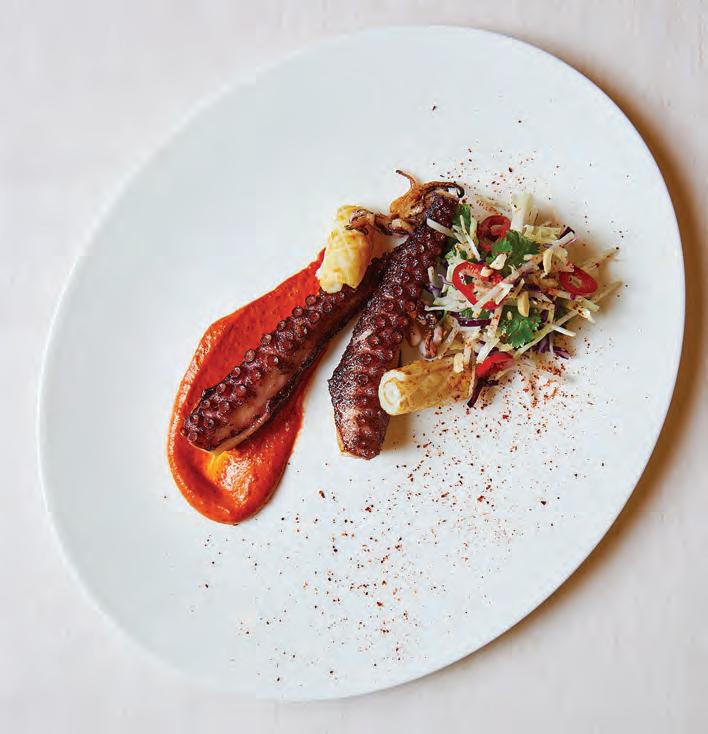
In a city where the restaurant scene can seem like blood sport, where one new place screams to redefine the art of dining as it climbs over the last hospice-bound place that tried to do the same, there are some spots that seem to quietly and effortlessly “get it.”
I’ve spoken to others who’ve dined at Four Twenty Five and the comparison to the original Four Seasons Restaurant has come up more than once. Before Four Twenty Five had even started serving lunch, people were calling it the new powerlunch spot. Both restaurants are large, airy, highceiling rooms that occupy corner spaces on bustling Park Avenue, and both have a mid-century aesthetic. The iconic Four Seasons was designed by Philip Johnson and Four Twenty Five was beautifully appointed by the legendary Lord Norman Foster and his team. Despite all the comparisons, Four Twenty Five is very much its own thing. And the timing for a new instant hot spot smack on Park Avenue in Midtown could not be better.
In a city where the restaurant scene can seem like blood sport, where one new place screams to redefine the art of dining as it climbs over the last hospice-bound place that tried to do the same, there are some spots that seem to quietly and effortlessly “get it” without hitting us over the head. Four Twenty Five is one of those places. It’s a space that welcomes you with an air of understated elegance and sophistication that feels as if it’s been there for ages.
That sophistication carries over onto the menu. Between the raw plates, the appetizers, the pasta dishes, and the entrées, accommodating lovers of meat, poultry, or fish, there is something for everyone. The Spanish mackerel with beech mushroom aged-sherry vinaigrette, or the foie gras terrine served with blood orange confit and spice bread madeleines, are delicious starters. Entrées include the seared Wagyu beef tenderloin complemented with broccoli roasted with pistachio crumbs; pan-roasted sea trout with pumpkin seed gramolata and butternut squash confit; and many other terrific creations. Even plant-based guests, who tend to be forgotten or get tossed compromised experiences on traditional menus, have a wonderful celeriac francese with tender leeks and Calabrian chili. For dessert? Dive into the dark chocolate mousse, the caramel custard, or an haute spin on a Mister Softee favorite: the pomegranate creamsicle.
Four Twenty Five offers an exquisite cocktail and dining experience in a glamorous setting. As for lunch? According to recent rumors, the power breakfast is back. And there is an open lane on the power-meal highway. With Four Twenty Five, Jean-Georges seems primed to take it.

And while we’re on the subject of famous French chefs making a splash on Park Avenue, let’s talk about Daniel Boulud’s recently resurrected Café Boulud. The 20-year-old restaurant has moved from its original location at the Surrey hotel, which closed during the pandemic in 2021, to 5,000 square feet at the new address 100 East 63rd Street, just off Park.
The prime location has had numerous (ultimately failed) incarnations, from Michael White’s clubby Vaucluse to Voisin to Park Avenue Café. Some say the space is jinxed. But Café Boulud’s interior design, by Jeffrey Beers, is going for a timeless, not trendy, vibe with a harmonious blend of warm, neutral tones (the pale gray walls are like the redone Daniel nearby), judicious pops of soft color, and plush upholstery. The space is instantly inviting, with velvet and leather seating in blue and amber, striking a balance between refined luxury and relaxed comfort.
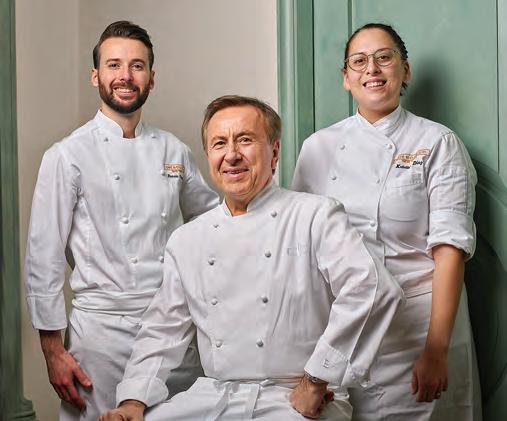

Explore our tropical-scented world. Visit our new concept store at 611 Madison Ave, NYC granado.us
GranadoBrazil


The eclectic two- or three-course dinner menus offer gastronomic journeys that reflect Chef Boulud’s commitment to culinary excellence with meticulous attention to detail in the seasonally updated signature sections: “La Saison” (seasonal fare), “Le Potager” (vegetables), “Le Voyage” (dishes from around the globe), and “La Tradition” (the classics). Along with prix fixe, dishes are also available à la carte.
Start with a salad of lobster, artichoke, potato, and mâche, and continue with a roasted sasso chicken breast in buckwheat butter, onions, fingerling potatoes, and mushroom fricassée. Or go for a citrus-grilled salmon with smoked roe, jalapeño, and avocado dressing, followed by a pan-seared rainbow Arctic char. In a vegetable mood? Try
Café Boulud continues to be a dining destination that transcends the ordinary.
And that classic black sea bass?
It’s still on the menu after 35 years.

the curried rainbow carrots with shallot compote then segue into the creamy rice polenta with vegan black caviar and fennel-orange compote.
For now, Café Boulud doesn’t serve lunch during the week, but the weekend brunch is beloved in the neighborhood, featuring classics by executive chef Romain Paumier like fluffy pancakes as well as a full menu of staples like smoked salmon, eggs benedict, and a perfect croque monsieur.
Café Boulud’s commitment to a great dining experience extends beyond the plate. The attentive, knowledgeable staff provide a level of polite service that is professional and personable—hailing back to when the customer always came first. Truman Capote’s swans would feel right at home.
In its new home (soon to include a buzzy bar
and the New York headquarters of Maison Barnes, the international real estate company from Paris and Daniel Boulud’s new partner), Café Boulud continues to be a dining destination that transcends the ordinary. And that classic black sea bass? It’s still on the menu after 35 years.
And on the subject of dress codes in this increasingly casualized world, it was refreshing to see the following policy posted on Café Boulud’s website: “Business casual attire is strongly recommended. Athletic or leisure wear is not permitted, and gentlemen are not permitted to wear shorts or sandals in the dining room. Baby strollers and prams cannot be accommodated in the restaurant.”
As if we couldn’t love Café Boulud more.
ART OF THE FEAST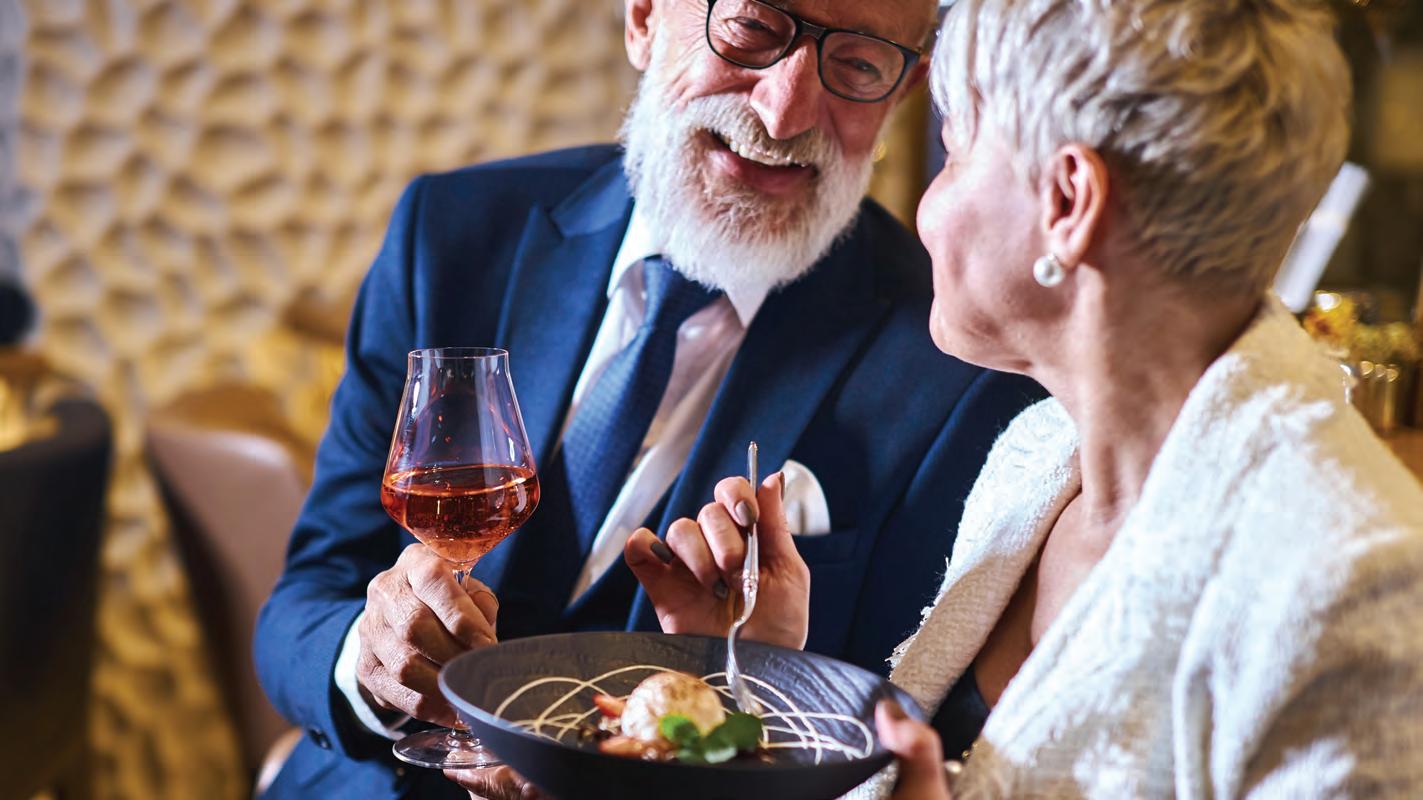
Inspīr Carnegie Hill elevates senior living in every sense. From our concierge services and dining venues to our immersive experiences and wellness philosophy.
Reserve your future today. Call our Inspīr care professionals at 646.907.1500 or visit inspirseniorliving.com




Martin Parr’s photographs have always shone a light on what people wear.
But he’s never published a book dedicated entirely to his fashion photography—until now.
Aria Darcella catches up with the artist who admits he’s not particularly interested in clothes.

Martin Parr loves books. To be clear, the famed photographer also loves photography (but we’ll get to that in a moment). But books—whether he is producing or collecting them—are a key interest.
“I’m looking at the design of books all the time,” Parr says. For better or worse, he picks up on ideas and conveys them to his book designers. “I’ve done over 100 books and not all of them are very good. I’ve done well, but I’m not gonna tell you which ones they are before you ask.”
If it’s not clear, the wry humor that is central to Parr’s photographs also comes out when he’s being interviewed. He is speaking to me over Zoom from the library of the Martin Parr Foundation in Bristol, England, which he opened in 2017 to support and celebrate the work of photographers focused on documenting Britain and Ireland. Softly, in the background, are the sounds of people flipping pages in books.
Best known for documentary photography, Parr has spent his career turning the mundane into a vivid, cheeky, and, as curator Thomas Weski has noted, borderline “grotesque” art form. His latest project is Fashion Faux Parr, a collection of fashion photography being released this spring by Phaidon. The tome features more than 250 images, some of which have never been published before. Despite having photographed fashion commercially and editorially since the ’90s, this is Parr’s first book dedicated to the subject (2005’s Fashion Magazine doesn’t count, as it was,
IN CROWDS Below: Paris Fashion Week in 2018, commissioned by Gucci. Facing page: spreads from Fashion Faux Parr.

per its name, a magazine). After taking on more work from fashion clients recently, Parr decided the time was right to finally devote a book to it. “Because people don’t know me as a fashion photographer, it was really fun to do something that hopefully people won’t have seen before— and may even be pleasantly surprised to see the aspiration,” he says.
For a photographer known for critiquing consumerism, it’s hard to say what’s more unexpected: that fashion brands tap him to lens their campaigns, or that he accepts the jobs. Parr even admits that he isn’t particularly interested in clothes. Instead, his only priority is to get an interesting picture. For his part, he’s happy to take a paycheck—especially when he can then use it to further invest in his foundation.
“This is a bit of a subversion, a bit of mischief,” he says. “Basically, I’m taking fashion pictures exactly in the style as I would do for myself. I’m just applying my language to a commercial problem to solve. Actually, it is about solving a problem: how do you make an interesting picture with people with these clothes on? In fact, I’ve been doing that all my photographic career.”
Said decades-long career has taken Parr around the globe, placed him in some of the world’s biggest galleries, and even earned him an appointment as a Commander of the Order of the British Empire. He’s learned a thing or two about people, and how to spot a good image. “Good pictures are very rare. I don’t take that many every year. Ten if you’re lucky, and really, probably, even that is exaggerating,” he says. “But even the weaker pictures have a role to play in terms of their documentation. And [that’s] what photography is all about: showing society as it is now through my eyes.”
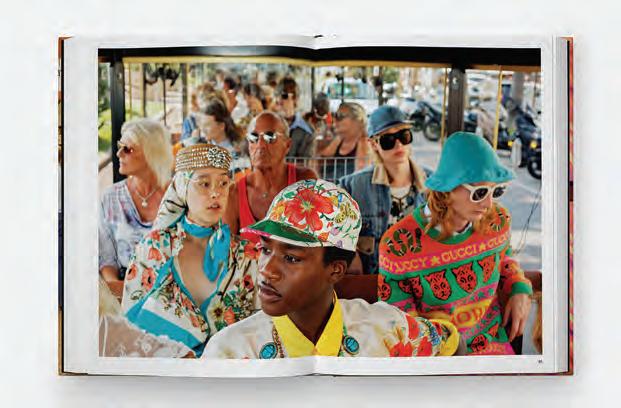


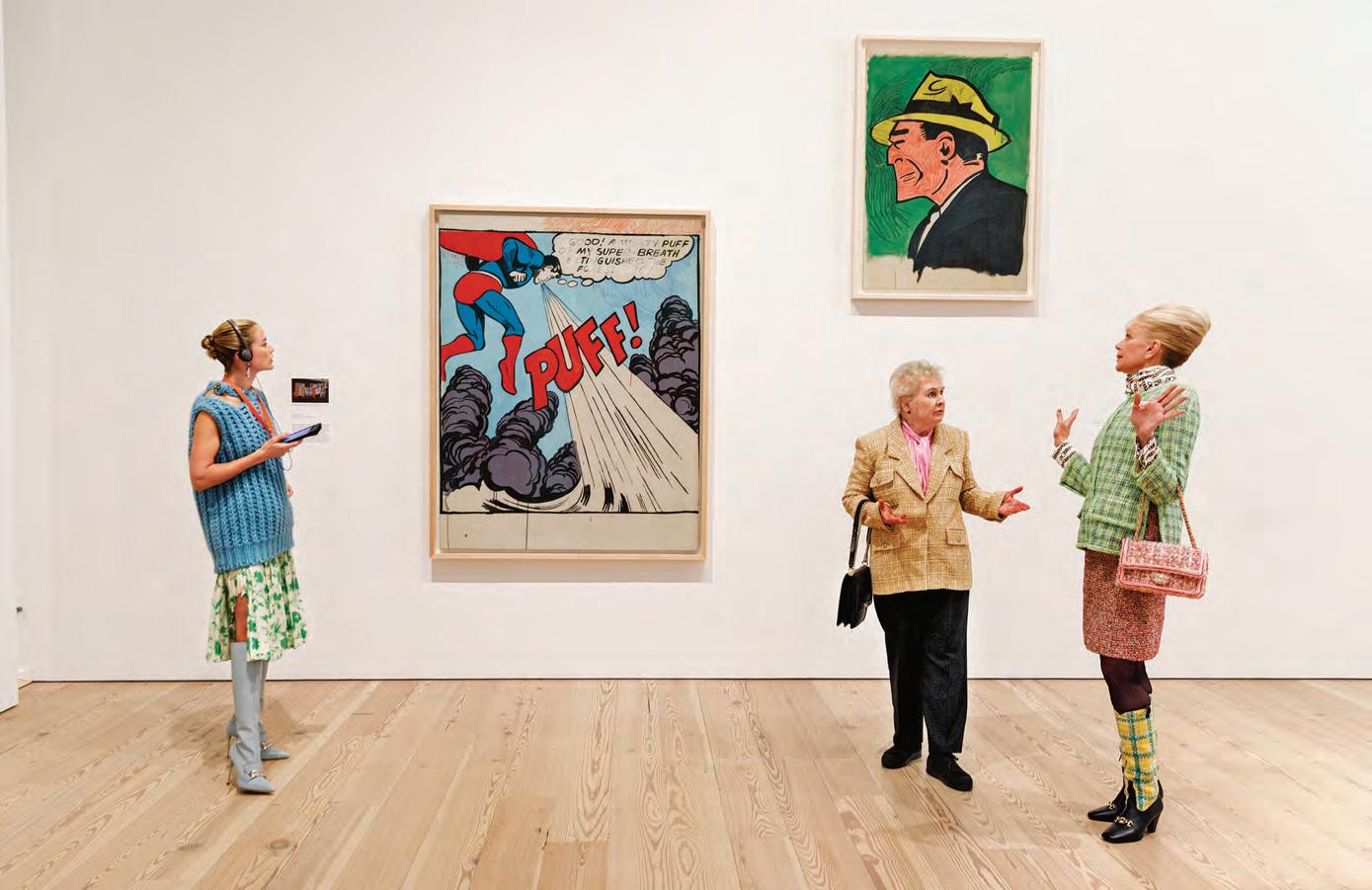
“Good pictures are very rare. I don’t take that many every year. Ten if you’re lucky, and really, probably, even that is exaggerating.”
—MARTIN PARR


“Basically, I’m taking fashion pictures exactly in the style as I would do for myself. I’m just applying my language to a commercial problem to solve.”
—MARTIN PARR

SPACE TO GROW Inside Ceysson & Bénétière’s New York outpost, showcasing the work of Noël Dolla.

The French art dealer
Maëlle Ebelle is director of both Ceysson & Bénétière’s Luxembourg and Upper East Side locations.
Annabel Keenan charts her global reach.
Who would trade the fairytale-esque villages of Luxembourg with the town houses of the Upper East Side? The answer, it seems, is Ceysson & Bénétière director Maëlle Ebelle, who moved to New York in May of 2023 to run the gallery’s Madison Avenue location. With spaces across France, Switzerland, Luxembourg, and New York, the gallery has established its global influence, in part thanks to Ebelle. Bringing her European expertise to New York, Ebelle joins associate director Francesca Pessarelli in overseeing Ceysson & Bénétière’s only U.S. outpost, which opened in 2017.
“I love the Upper East Side,” Ebelle tells Avenue “The proximity with all those beautiful institutions and amazing galleries is really stimulating.
I am at the beginning of this new artistic life and very excited about it.”
Ebelle’s journey parallels much of Ceysson & Bénétière itself. She was born in France and grew up in Saint-Étienne where the gallery has a stunning, sprawling location, though that came years later. She studied history at the Université Jean Monnet, Saint-Étienne, and art history at the Université Paul Valéry Montpellier 3. From there, she went to South Africa to continue her studies at an international school.
Embarking on her professional career, Ebelle joined Ceysson & Bénétière in May 2012 in Switzerland at the gallery’s Geneva location and remained for two years before moving to Luxembourg, where the team was working towards opening a new space. She took the helm of the Luxembourg outpost as director in 2017 and worked there until her arrival in New York last year. The move, Ebelle
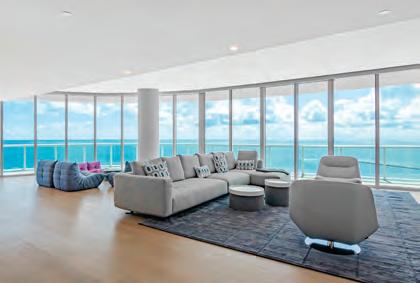


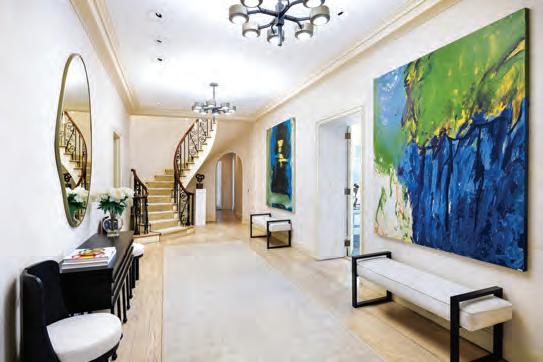


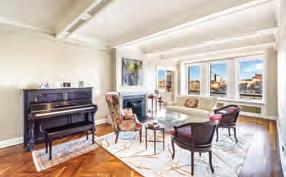
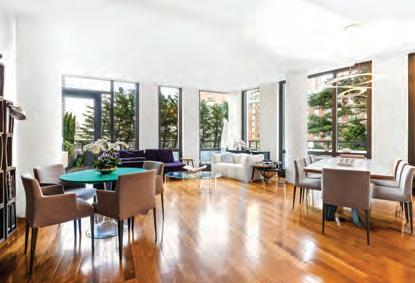
1. Double Unit at the Iconic Continuum South Beach
Miami Beach, FL. 5BR. 4 Bath. $23M. Web #11513424.
Sonia Toth 786-351-0808
Keith Marks 786-999-5898
2. Private 10-Acre Waterfront Compound
Greenwich, CT. 6BR. 5.5 Baths. $18.5M. Web #119098
Christopher B. Finlay 203-969-5511
3. The Epitome of Palm Beach Palm Beach, FL. 7BR. 5.5 Bath. $32.5M. Web #10928595.
Liza Pulitzer 561-373-0666
Whitney McGurk 561-310-7919
4. Palatial Prewar Masterpiece 760 Park Avenue. Co-Excl. 9BR. 7.2 Bath. $25M. Web #22889183.
Lisa K. Lippman 212-588-5606
5. Carnegie Hill Candela Nine 1220 Park Avenue. 5BR. 3 Bath. $5.295M. Web #22893273.
Amanda S. Brainerd 212-452-4515
Simone Mailman 212-452-6209
Gerard Ryan 212-452-6262
6. Renovated Prewar 3 Bedroom with River Views
25 East End Ave. 3BR. 3 Bath. $3.25M. Web # 22864987.
Wendy J. Sarasohn 212-906-9366
Jamie S. Joseph 917-215-5993
Maria Pashby 917-520-0592
Joanna A. Pashby 917-623-9123
7. Hamptons Oceanfront with Bay Dock Quogue, NY. 5BR. 4 Bath. $8.85M. Web #908779.
Lauren A. Battista 631-288-5534
8. Duplex Condo in TriBeCa 99 Warren Street. 4BR. 3 Bath. $5.995M. Web #22894277.
Senad Ahmetovic 212-317-7867
“New York is a fantastic platform for European artists.”
—Maëlle Ebelle

explains, was a long time coming.
“Moving to New York is a project we’ve thought about with François Ceysson and Loïc Bénétière since the opening of the Upper East Side gallery in 2017,” she explains. Like so many other plans underway during the pandemic, the gallery had to wait until the timing was right. “Patience has been the best ally,” she says.
Serving as the director of both the Luxembourg and Upper East Side spaces, Ebelle plans to help the gallery further develop its transatlantic influence. “The program of the New York gallery differs a bit from the European locations,” she explains, adding, “but don’t forget that New York is a fantastic platform for European artists.”
To this end, Ebelle has helped stage exhibitions by some of the European artists on the gallery’s roster, including a celebrated, multimedia show by Paris-based Jean-Luc Verna from October to

December of 2023 that explored themes ranging from queer culture and Greek mythology to art history and underground rock.
“I discovered Jean-Luc Verna years ago,” Ebelle says. “The entire installation of the show was a dialogue between us, a perfect moment. It is the way I like to work with the artist. My favorite piece was a work from 2023 called Mimine. I love the construction of it. We can see the technique Jean-Luc uses—quite academic—and I love the stickers on top of it, which trouble the academism of the original drawing!”
Ebelle has also assisted in developing Ceysson & Bénétière’s strong program of exhibitions by artists from Supports/Surfaces, the art collective that emerged in 1966 in the South of France during a nationwide period of civil unrest. The revolutionary artists believed in the importance of the materiality of painting stripped down to its funda-
mental elements: the supports and the surfaces. Ceysson & Bénétière has long been a leader in Supports/Surfaces, championing artists such as André-Pierre Arnal, Noël Dolla, Patrick Saytour, and Claude Viallat. With its Upper East Side location, the gallery has helped introduce these artists to new audiences.
The team has also expanded its roster, bringing in rising stars of the industry, including Brooklynbased artist Rachael Tarravechia. They plan to continue to tap into the vast network of artists in New York over the years. “We are trying to foster new collaborations with local artists, while standing with the European artistic line of the gallery,” Ebelle says.
This interest in both European and American artists is apparent throughout Ceysson & Bénétière’s program. The recent solo show “Never Ever Land” saw American artist Adam Himebauch turn the





gallery space into a bedroom, sleeping in a livestreamed performance that considered the legacy of audience participation in performance art, a concept spearheaded by Serbian artist Marina Abramović.
For its spring show, Ceysson & Bénétière is continuing its cross-cultural dialogue with a solo exhibition of work by New York-based, Belarusian artist Alina Bliumis. Known for her dynamic practice that spans painting, drawing, printmaking, weaving, and sculpture, Bliumis creates stunning pieces that address a wide range of issues from the environmental impact of climate change to identity, migration, bodily rights, and the history
of war. Her striking, anthropomorphic drawings of endangered flowers in the show have custom frames that the artist hand carved.
“We have been interested in Alina’s works for a while now, keeping an eye as part of art fairs and group shows, and the occasion to present her work in March was a perfect match for both her and the program,” Ebelle enthuses.
While it took patience for her to move to New York, Ebelle’s tenure on the Upper East Side is flourishing at rapid speed. For her and the Ceysson & Bénétière team, the future promises an even deeper transatlantic cultural exchange.
“Florephemeral,” a solo show by Alina Bliumis, runs March 21–April 27.

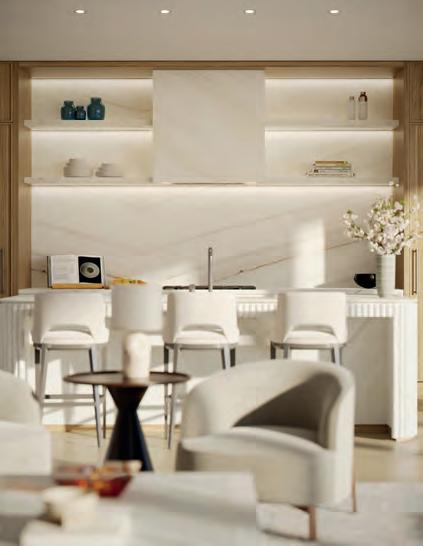
Inside four Upper East Side powerhouse galleries to visit this spring.
BY ANNABEL KEENAN
Before the establishment of Chelsea, SoHo, and Tribeca as art world hotbeds, New York’s Upper East Side was at the forefront of the industry for decades. Dealers of art and antiques have operated in the neighborhood for generations, some to this day, including Acquavella Galleries, which is over a century old. As the Upper East Side and the art world developed, blue-chip powerhouses and top galleries opened outposts over the years both temporarily and on a permanent basis.
Today, the Upper East Side is exploding with established and emerging dealers offering the best
and newest names in contemporary art, as well as the most coveted figures from generations past. Anchored by august institutions like Gagosian, Mnuchin, David Zwirner, and Hauser & Wirth, and bolstered by foot traffic from the chic stores and world-class museums along Madison and Fifth Avenues—the Metropolitan Museum of Art and Guggenheim, to name two—the area remains a driving force in the art market. And the art world is buzzing with the news that Sotheby’s is opening in the iconic Brutalist building by Marcel Breuer which was formerly the Whitney Museum of American Art. Sotheby’s plans to take over the Breuer building in September 2024.
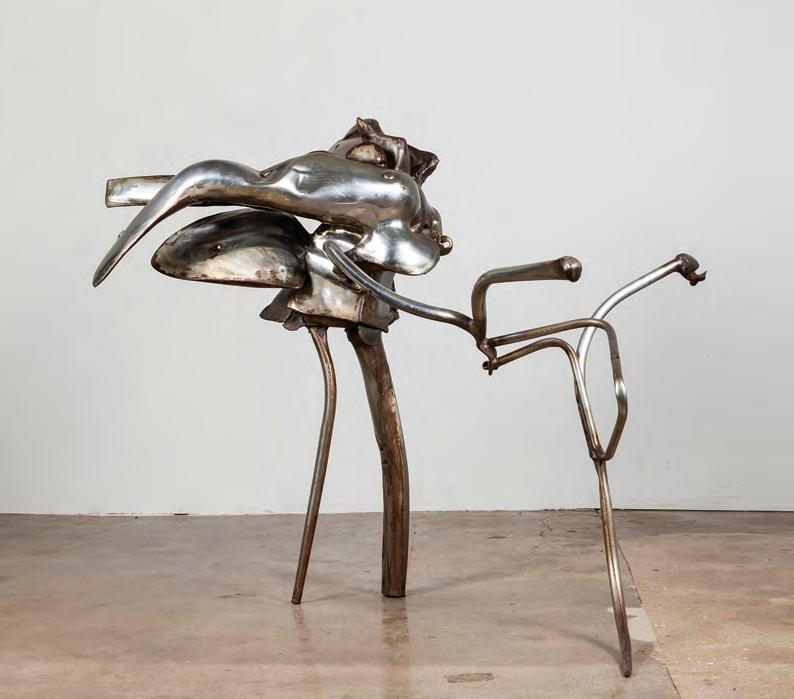

The Upper East Side is exploding with established and emerging dealers offering the best and newest names in contemporary art, as well as the most coveted figures from generations past.
From blue-chip titans to newcomers with eyes for spotting talent, here are four top Upper East Side galleries to visit this spring.
WHITE CUBE
1002 Madison Avenue
The latest newcomer to the Upper East Side is White Cube, which opened its Madison Avenue doors this past October, adding to its impressive global roster of galleries in London, Paris, Hong Kong, and Seoul. Established over 30 years ago in London, White Cube has become a leading gallery, representing some of the biggest names in contemporary art, such as Julie Mehretu, Damien Hirst, and Tracey Emin, while also stewarding prominent artist estates. This March, White Cube is presenting a solo exhibition of Richard Hunt, the renowned American sculptor who passed away in December of 2023. Working mainly in metal, Hunt had a prolific, six-decade career creating fluid forms that blended abstraction with hints of surrealism, and drew inspiration from science and the natural world. Featuring works from early in the artist’s career, including many from Hunt’s groundbreaking 1971 MoMA solo show—the first time the museum gave an African American sculptor a retrospective—the exhibition offers viewers a close look at the foundations of the late artist’s practice.
FORMS AND FIGURES Left:
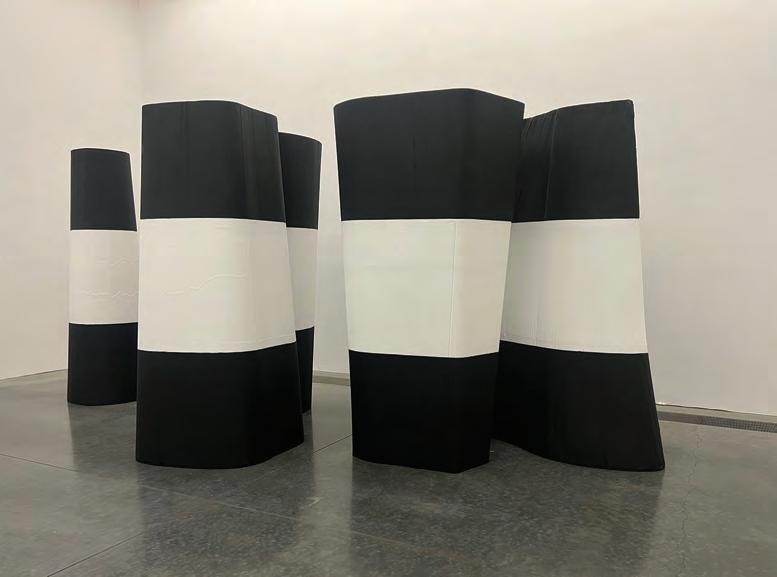

24 East 81st Street, 4A
A staple of the New York art scene since 1987, David Nolan Gallery established itself with locations in SoHo and Chelsea before making the Upper East Side its home in 2020. In the nearly 40 years since opening, David Nolan Gallery has staged early exhibitions by artists who would go on to become some of the biggest names in modern and contemporary art, including Richard Artschwager, Albert Oehlen, Gerhard Richter, and Rosemarie Trockel. For its first spring show, the gallery is mounting “Cutting Corners,” a solo exhibition of new work by leading American sculptor Mel Kendrick that opens March 7 and runs through April 13. Working in a variety of materials, including cast bronze, wood, concrete, rubber, and resin, Kendrick’s abstract work draws inspiration from minimalist and conceptual art to push the boundaries of form and material. Greatly interested in the artistic process and how we experience sculpture, Kendrick’s works are self-referential and invite viewers to consider each piece in relation to their own bodies.
39 East 78th Street, 2nd Floor
With numerous branches throughout Europe and Asia, and both the Upper East Side and Tribeca, Almine Rech has become a top global gallery since its founding in Paris in 1989. In the decades since, Almine Rech has supported the careers of renowned artists like James Turrell, John McCracken, and Jeff Koons, while also fostering the growth of some of the most promising names in contemporary art,
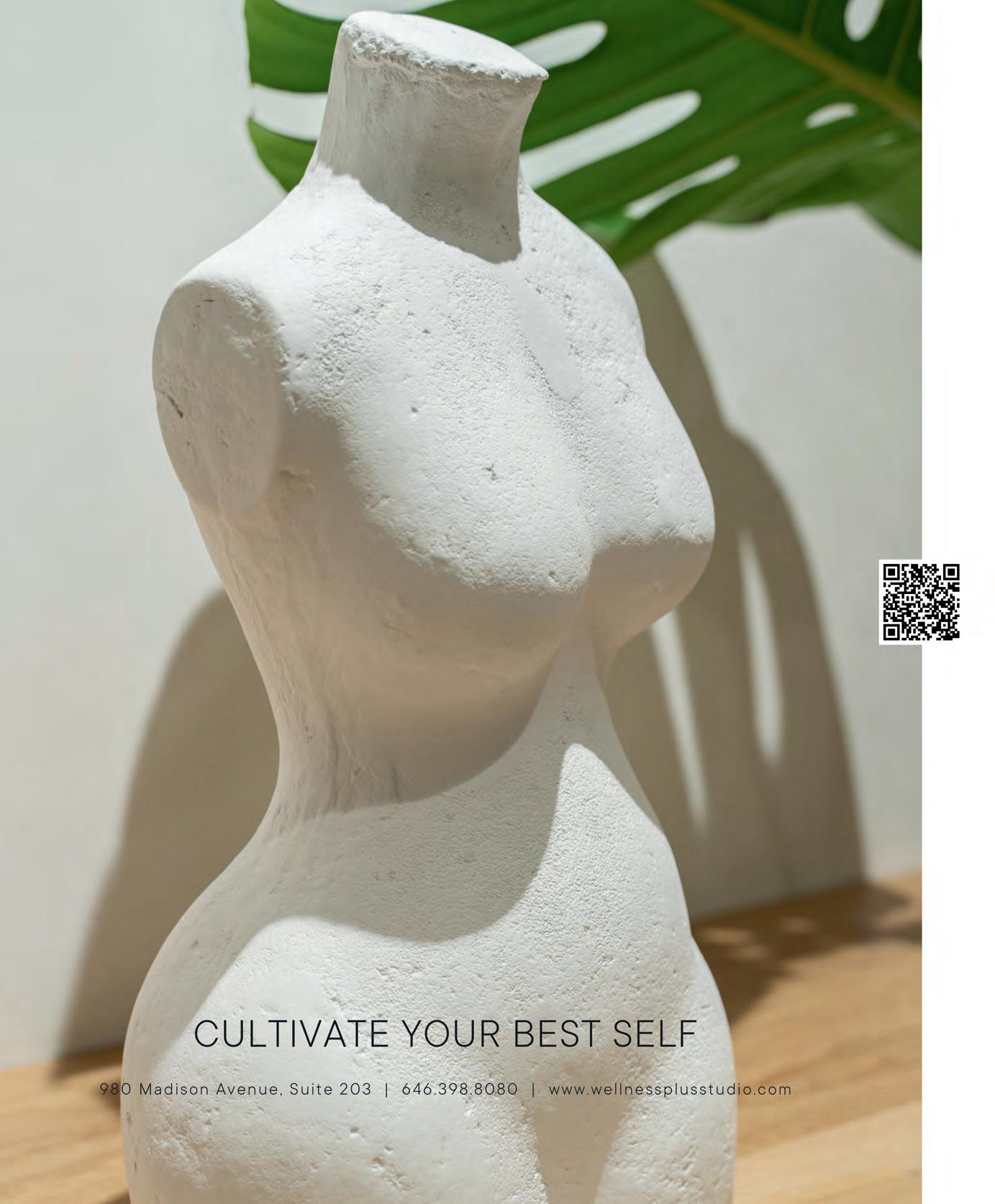
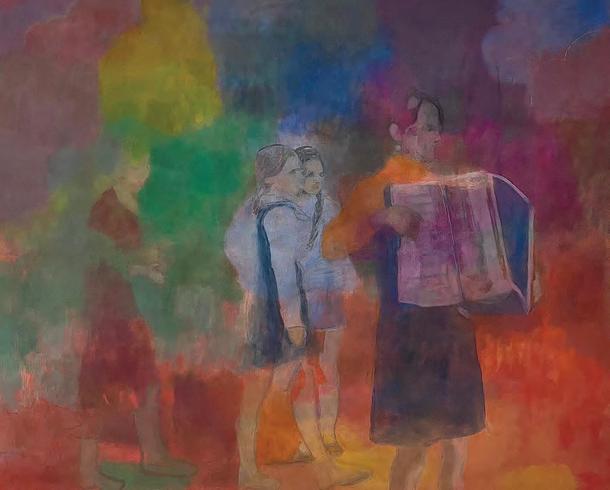


including Claire Tabouret and Chloe Wise. This March, the gallery is showcasing works by rising figurative painter Jessica Valice, whose big-eared characters with large, emotive eyes set in heavy eyelids explore elements of the human condition. Simultaneously familiar and foreign, comfortable, and off-putting, romantic and melancholic, Valice’s figures underscore the range of emotions and states that humans are capable of feeling, as well as the inherent subjectivity in deciphering them.
ALEXANDER BERGGRUEN
1018 Madison Avenue, Floor 3
Launched in 2019, Alexander Berggruen has quickly made a name for itself with a robust program that spans 20th-century and contemporary art. With an eye for emerging talent, Alexander Berggruen has mounted significant exhibitions of rising stars of the industry, including Sholto Blissett, Hulda Guzmán, and Brittney Leeanne Williams. To bring in the spring season, the gallery is staging a group show featuring artists who explore the effects that technology, nature, interpersonal relationships, and material transformations have on mental processes. On view through March 27, the show includes paintings and sculptures by Drew Bennett, Laird Gough, Lyndsey Marko, Alexandria Mento, Dominic Musa, and Ben Walker. Following this thought-provoking presentation is a solo show of landscape paintings by Cara Nahaul entitled “Tender Islands,” which opens April 10 and will be on view until May 8. Inspired by the artist’s own home in the United Kingdom and those of her parents in Mauritius and Malaysia, the new body of work in the show blends real and imagined histories to inspire the viewer to consider how they create their own sense of self.



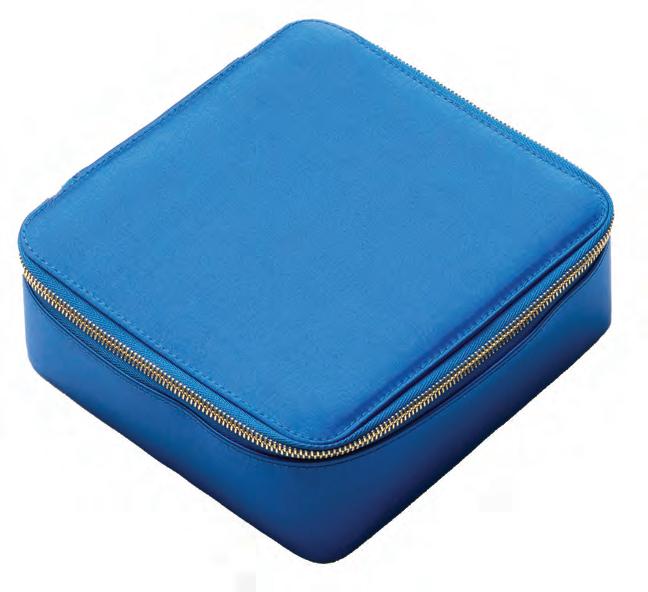


“THERE WAS ONE PERSON WHO TRULY DID VALUE MONEY AS AN END TO ITSELF. HE LITERALLY WANTED HIS NET WORTH ON HIS TOMBSTONE.”
–DR. LISA NAPOLITANO
NEW YORK’S SILVER-SPOON KIDS ARE WAKING UP WITH A FRESH SET OF VALUES. MIKE ALBO DELVES INTO THE DEPTHS OF THE NEW AGE OF TEEN ANTI-ENTITLEMENT ENLIGHTENMENT.
Say what you will about the rich kids of Manhattan, but they usually know more than their parents about social media—that one clueless, poolside post from the Maldives can lead to a million mean reaction videos on TikTok. But in this time when “privileged” has become one of the most insulting adjectives, a wave of affluent progeny are showing that they want more than stealth wealth while slumming it in Dimes Square. For example, right out of college, Anna Pei (granddaughter of architecture icon I.M. Pei) founded an archival business, Ode, that works with select, high-end families.
“To be able to afford to live here [in New York City] decently offers a distorted picture,” says Dr. Lisa Napolitano, a licensed clinical psychologist in Miami and New York working with parents and children of means. “There’s a tendency to compare yourself, but you are really comparing yourself to a skewed sample.”
Take, for instance, the family who ordered
takeout from three different places nightly, leaving them with boxes of food like Wegmans at 8:30 PM, until they realized they would save thousands of dollars with a personal chef.
“In Manhattan, with private schools in the mid50ks, there’s a bit of a cognitive disconnect,” says Rosalind Wiseman, author of the landmark book Queen Bees and Wannabes: Helping Your Daughter Survive Cliques, Gossip, Boyfriends, and the New Realities of Girl World and Other Realities of Adolescence (the basis for Mean Girls). That makes teaching a kid to be “anti-entitled” in this city difficult. Especially when, by age three, every morning, they were asked, “Do you want a croissant or a scone?” Having a 24-hour driver to take your teen from your Brooklyn Heights brownstone to Avenues every day is how Kendall Roy of Succession grew up, not normal people.
“There isn’t a lot of interaction going on. With their handy smartphones, parents are constantly monitoring their kids,” says a Manhattan high school principal. “Also, these kids are all really

booked. Between extracurriculars and soccer practice and gymnastics, who has time to step outside their demographic and meet someone different than them?”
“I have to coach my kids not to talk about their lives—going to openings and trips and stuff,” says a successful theater professional. Hopes are that your kid doesn’t flaunt their wealth like the rich high schooler who buys a $500 sweater almost every day after school and then throws it in the trash. “Especially when going to school with different financial brackets. It’s not about being embarrassed, it’s about knowing your audience.”
Given phones to stare into and a classroom filled with other kids in their class status creates a generation of children who don’t have basic social skills in public. The red flag? When they are rude to a waiter or doorman.
“They need to learn that you won’t protect them when they are obnoxious,” says Wiseman. “Don’t apologize for them. If you see them being rude to a service person, say, ‘On behalf of my family and my child, I am really sorry,’ and say
that in front of the child. There’s a time when good embarrassment is a good thing.”
Dressed to Suppress
While teaching your child not to gloat is important, the issue of entitlement can’t be swept under the Persian carpet. Therapists agree that hiding or creating an atmosphere of secrecy around your wealth does more harm than good. “Denying your wealth is a form of repression,” explains Dr. Napolitano. And if you are not honest— or, even worse, ashamed—about your money, a child will pick up on it with their mysterious emotional antenna. It’s a vibe thing, as the kids say.
“Pretending not to be rich or privileged doesn’t work,” explains Rick Miller, LICSW psychotherapist in private practice based in Boston and Cape Cod. “You are giving them a message not to be who you are. You end up projecting a social awkwardness because you aren’t really allowed to let your breath out.” We’re talking about the socialite who tips terribly, always complains she’s broke, and makes her daughter fly coach. Adds Dr. Napolitano: “Social anxiety is the fear of negative evaluation. In this case, looking affluent.”
“I HAVE TO COACH MY KIDS NOT TO TALK ABOUT THEIR LIVES—GOING TO OPENINGS AND TRIPS AND STUFF, ESPECIALLY WHEN GOING TO SCHOOL WITH DIFFERENT FINANCIAL BRACKETS. IT’S NOT ABOUT BEING EMBARRASSED, IT’S ABOUT KNOWING YOUR AUDIENCE.”
–A THEATER PROFESSIONAL
This social anxiety has only worsened since the pandemic. In our post-Covid era, when second homes are secondhand, socializing has whittled down, and there’s less connection happening. “Young adults are more isolated. I do think the social landscape has changed,” observes Dr. Napolitano. “I have clients who just entered the workforce, and it’s not the NYC of happy hours and nightlife on the level it was before. So many of those social avenues have been disrupted,” leading many to hide under their Pendleton blankets in their Hudson Yards apartments ordering from Caviar, not even realizing their own social agoraphobia.
An expert in cognitive behavioral therapy, one of the first steps Dr. Napolitano takes to get a client out of their shame cloud is to flip the script. “The task is to engage in gratitude practice. Rather than feeling guilty, feeling grateful.” Dr. Napolitano works with clients on a “values inventory.” “It’s a conversation, a series of questions, and we examine to what extent these values are reflected in their life as it’s currently led.”
Cognitive behavioral therapy is about actions, which is why it’s such a popular form of therapy for New Yorkers. “Once we identify the values, we set goals that advance their values and create meaning: joining a group, volunteering, donating time. If someone has social anxiety, it’s not easy work. ” Dr. Napolitano reports. It takes months, but change happens.
Not for everyone, though. “In over 20 years, there was one person who truly did value money as an end to itself,” remembers Dr. Napolitano. “We do an epitaph exercise (‘What would you want
written on your grave?’), that typically helps people realize what’s important. He literally wanted his net worth on his tombstone.”
“I know plenty of wealthy families with anti-entitled, well-adjusted kids and there is a theme,” says Wiseman. “For their first job, they worked in hotels and did maid service or dishwashing at a restaurant. If they do that, your children are going to deeply respect how hard people work in the service industry.”
Anna Catherine Rutledge runs The Ethical Teen, an interfaith coming-of-age program she developed after her own son turned 13. “I felt a calling when my kid was coming of age.” In a city where someone hired Cardi B and the Knicks City Dancers to perform at Tao for their son’s bar mitzvah, it’s important to level set expectations.
Rutledge arranged for her son to take a class in ethics, and then he organized a fundraiser for a boys’ soccer team in Costa Rica, wrote an essay with his speech therapist, and more. “Then we had a party and celebrated him.” Now she has developed a program for others in four parts: community service and volunteering; fundraising; organizing a party; and writing an essay of thanks to parents and others in their life. The party: a backyard BBQ with hotdogs and notdogs.
An all-important aspect of The Ethical Teen is a series of value-based questions that get increasingly more thought-provoking. From “Tacos or burritos?” to “Would you rather be rich or smart?” they coax the teens to articulate their values and
seek healthy role models. “Who do white boys have to look up to? Andrew Tate? Some gamer playing Minecraft?” asks Rutledge. “It’s crucial for them to find older people who they can trust who aren’t just their parents.”
Essentially, being anti-entitled is about understanding your core values and connecting with others through them. “Living a life without mindful awareness of your values is like sailing a ship without a rudder,” says Dr. Napolitano, who also incorporates her Buddhist practice into her work. “Really so much depression stems from a sense of isolation. We are all interconnected; separateness is an illusion.” This is a core belief that has no price tag. “The values of being connected and sincerely giving back cuts across all economic groups,” says Miller.
And this is where our city can be the best medicine. Economic diversity is right outside your door. Just a short subway ride will take you to Queens, where you can go to a Venezuelan restaurant serving authentic arepas from our newest hardworking immigrants.
One parent watched her teen son transform from brat to benevolent after (as a punishment) she signed him up to volunteer at a food pantry. “He was hanging out with these awful bros, being a little shit, until he saw how other people live, and realized how little he knew of the world.”
The bottom line is, teach your child to keep their hearts and minds open. Lead by example with your own generosity.
And just give them a scone and be done with it.
WARMER DAYS, SHORTER NIGHTS, AND EVERYTHING IN BLOOM: A SEASON OF RENEWAL IS UPON US. HOW WILL YOU REINVENT YOUR WARDROBE?
COLLAGES BY NATALIE D. KACZINSKI
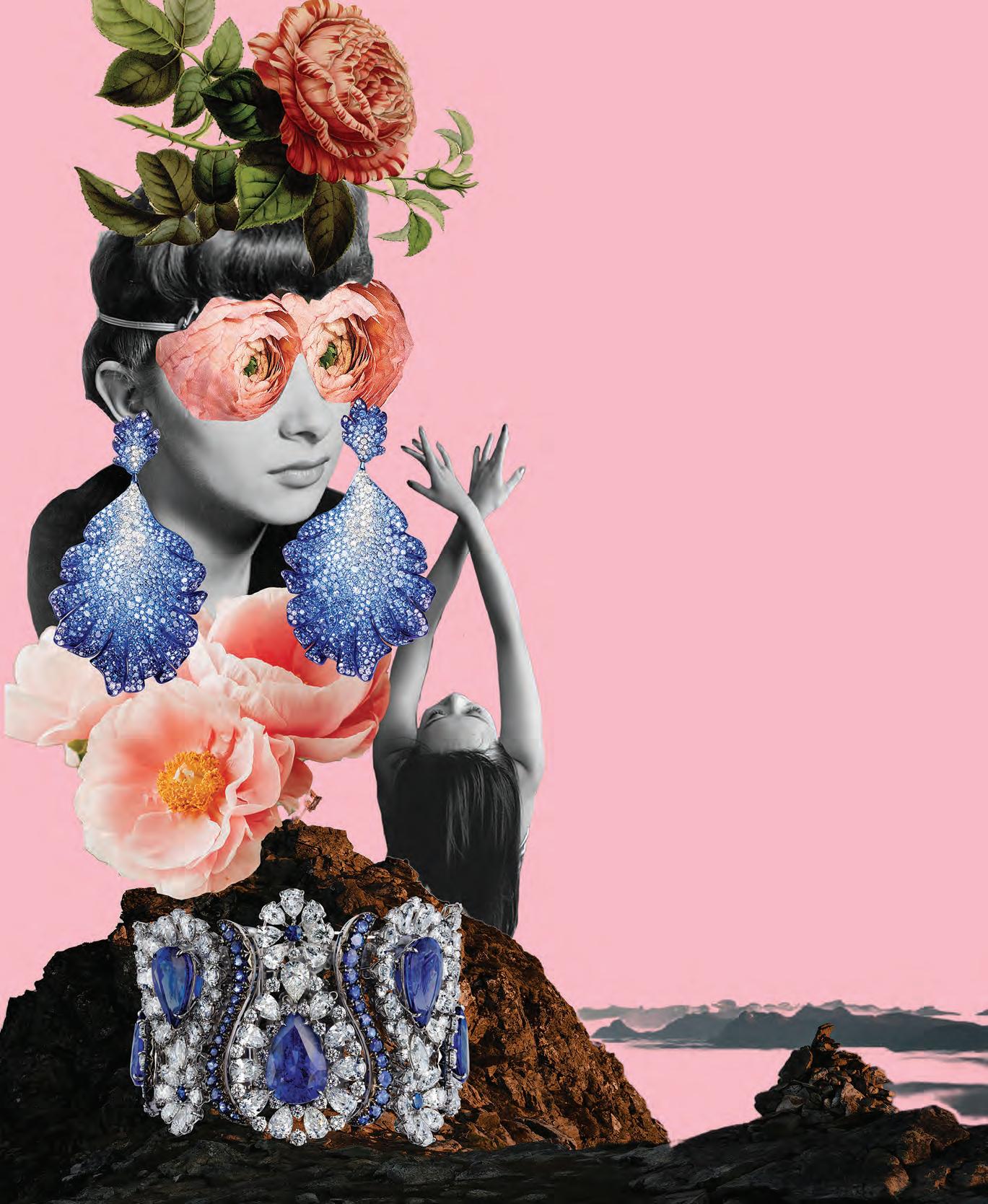
Chopard “Red Carpet Collection” earrings with blue and violet sapphires and diamonds, and a bracelet from the “Haute Joaillerie” collection with tanzanites, diamonds, and sapphires in 18k white gold. Prices for both available upon request; chopard.com

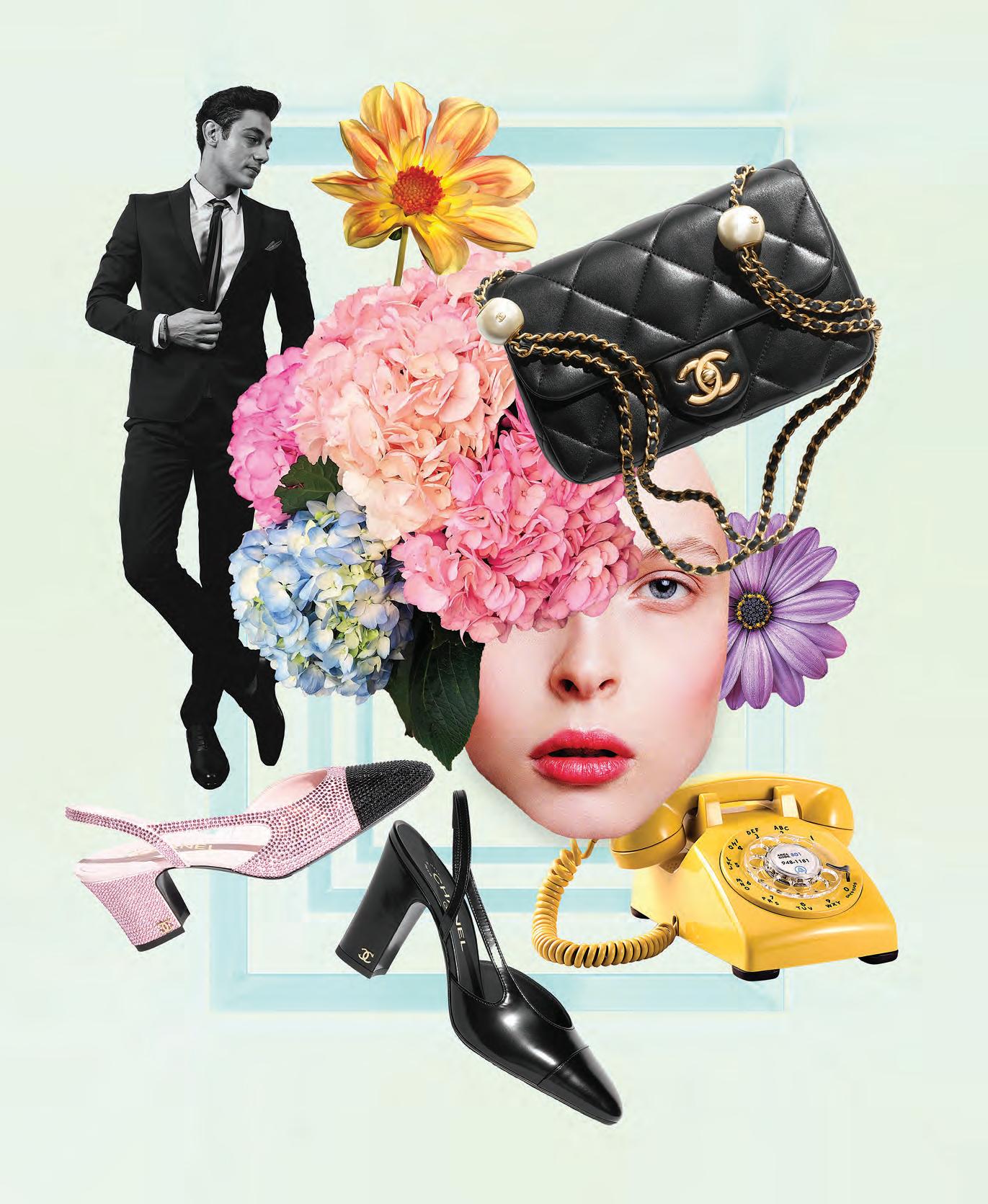

Graff earrings with yellow diamonds set in yellow and white gold, price upon request, and the “Tilda’s Bow” diamond ring in white gold, $42,000; both available at graff.com

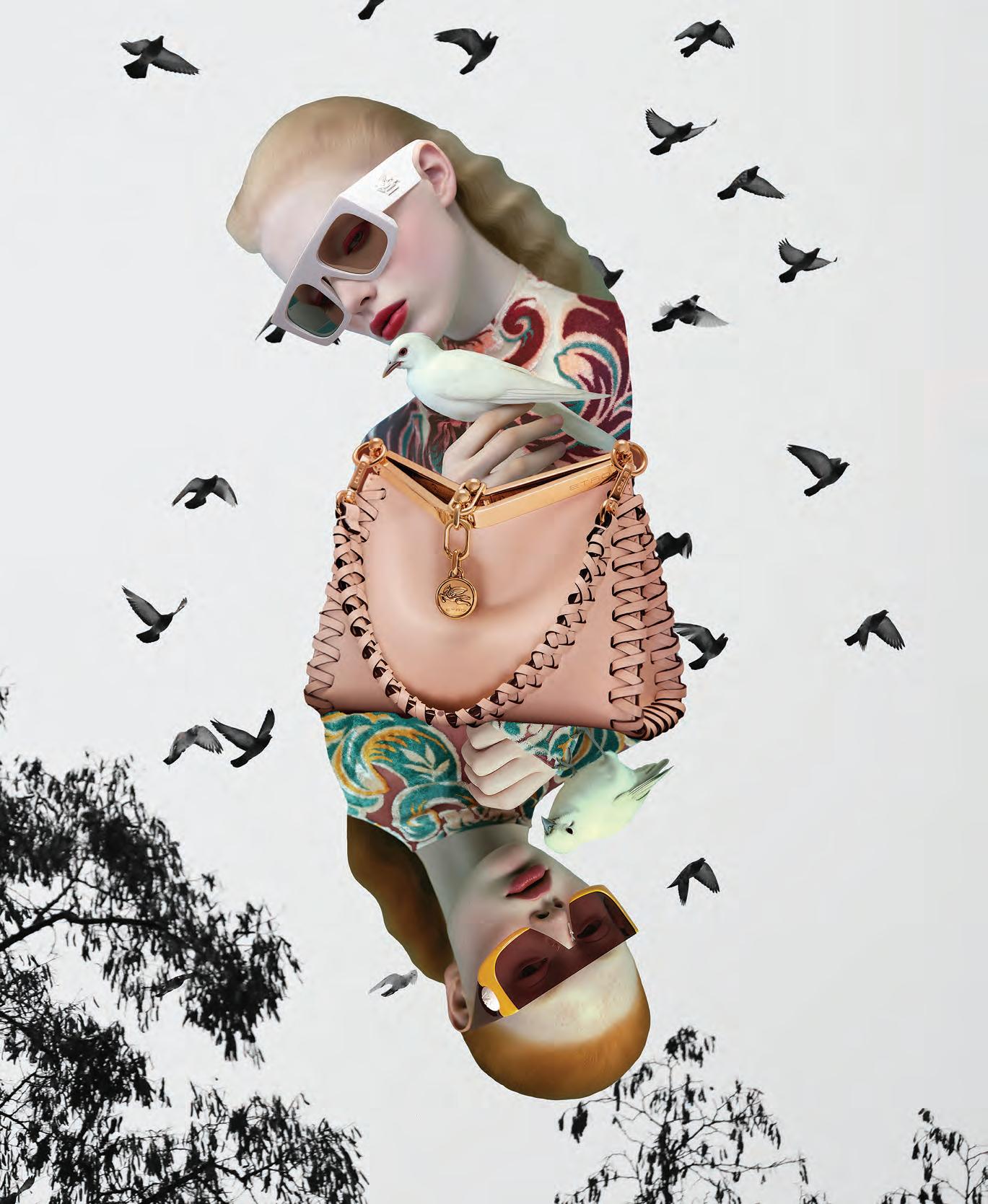
Etro “Etroscreen” sunglasses, $290; mini threaded “Vela” bag, $3,350; and “Etromacron” sunglasses, price available on request; etro.com

Carolina Herrera “Doma” leather sandals, $520, and raffia bucket hat, $295; carolinaherrera.com
 Paul Morelli “Ultimate” diamond and gold hoop earrings, $13,500, and “Cuban chain” gold hoop earrings, $4,800; paulmorelli.com
Alexander McQueen small “Peak” bag. $3,200; alexandermcqueen.com
Alexander McQueen “Armadillo” kneehigh boots. $2,200; alexandermcqueen.com
Paul Morelli “Ultimate” diamond and gold hoop earrings, $13,500, and “Cuban chain” gold hoop earrings, $4,800; paulmorelli.com
Alexander McQueen small “Peak” bag. $3,200; alexandermcqueen.com
Alexander McQueen “Armadillo” kneehigh boots. $2,200; alexandermcqueen.com
 Valentino mini “Moon” bags. $2,390 each; valentino.com
Asprey “Chaos” amethyst and rose gold earrings. $7,995; available at Asprey Madison Avenue
Valentino mini “Moon” bags. $2,390 each; valentino.com
Asprey “Chaos” amethyst and rose gold earrings. $7,995; available at Asprey Madison Avenue
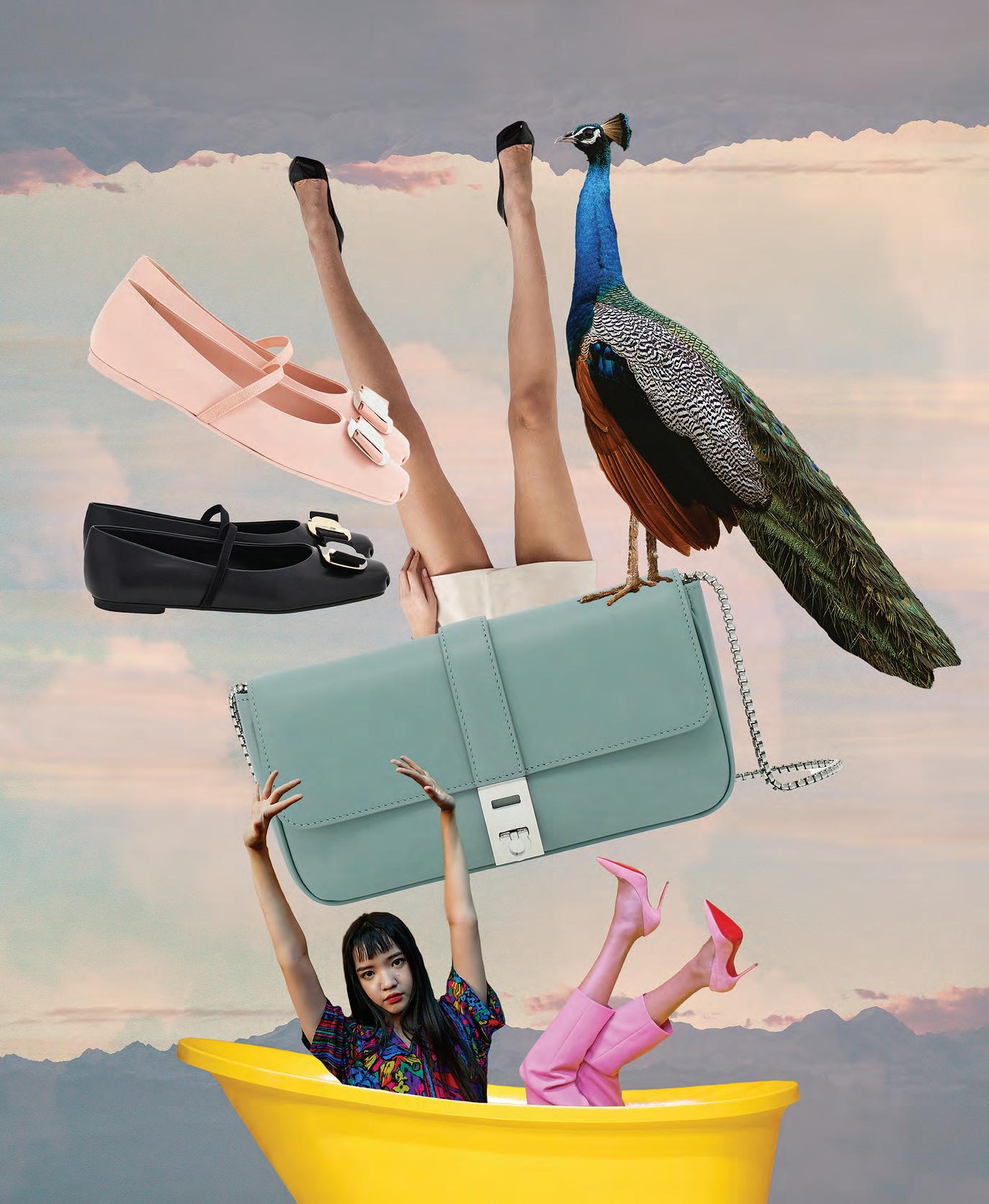


Skiers are a fanatic global tribe. They’re like members of an obsessive club searching the globe for fresh powder—and a hot social scene. There are the risk-taking adrenaline junkies who live to shred down double black diamond slopes; and then there are the wealthy jet-setters who prefer to meander down the mountain in Moncler puffers before racing to an après-ski spot to sip Moscow mules. The ski resort one chooses says everything about them. For example, stylish socialites descend upon Saint Moritz, Gstaad, and Courchevel in Europe. But true daredevil skiers and snowboarders swear by the death-defying jagged peaks of Jackson Hole in Wyoming. And Jackson’s coolest place to shack up is Caldera House, the luxury hotel/private members’ club in the heart of Teton Village, just steps away from Jackson Hole Mountain Resort’s iconic cherry-red tram cars.
Caldera House is not your average hotel. It feels like you’ve moved into your own private apartment. There are just four 1,500-square-foot two-bedroom suites and four 5,000-square-foot four-bedroom suites. Designed by LA-based Commune (who did Chicago’s Ace Hotel) and local studio CLB Architects (who also designed the actual building), the suites are loft-like with massive state-of-the-art chef’s kitchens, dining rooms, home theaters, snow-melting patios with Solus firepits, and bathrooms with tin tubs.
It took six years and more than $100 million to bring Caldera House to life thanks to the vision of Wes Edens, a cofounder of Fortress Investment Group, the co-owner of the Milwaukee Bucks, and a former ski racer. Along with three partners (Mi-

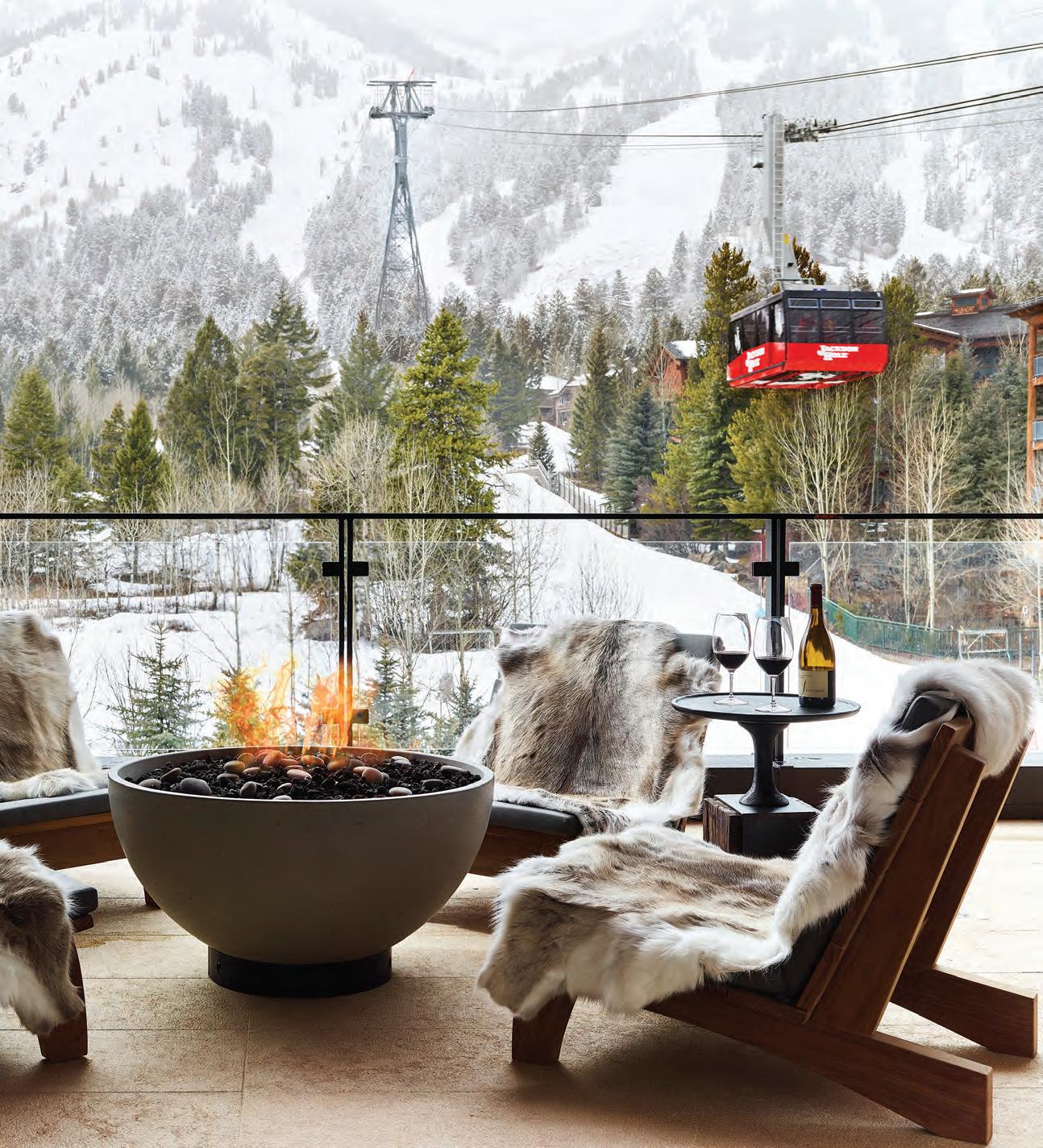
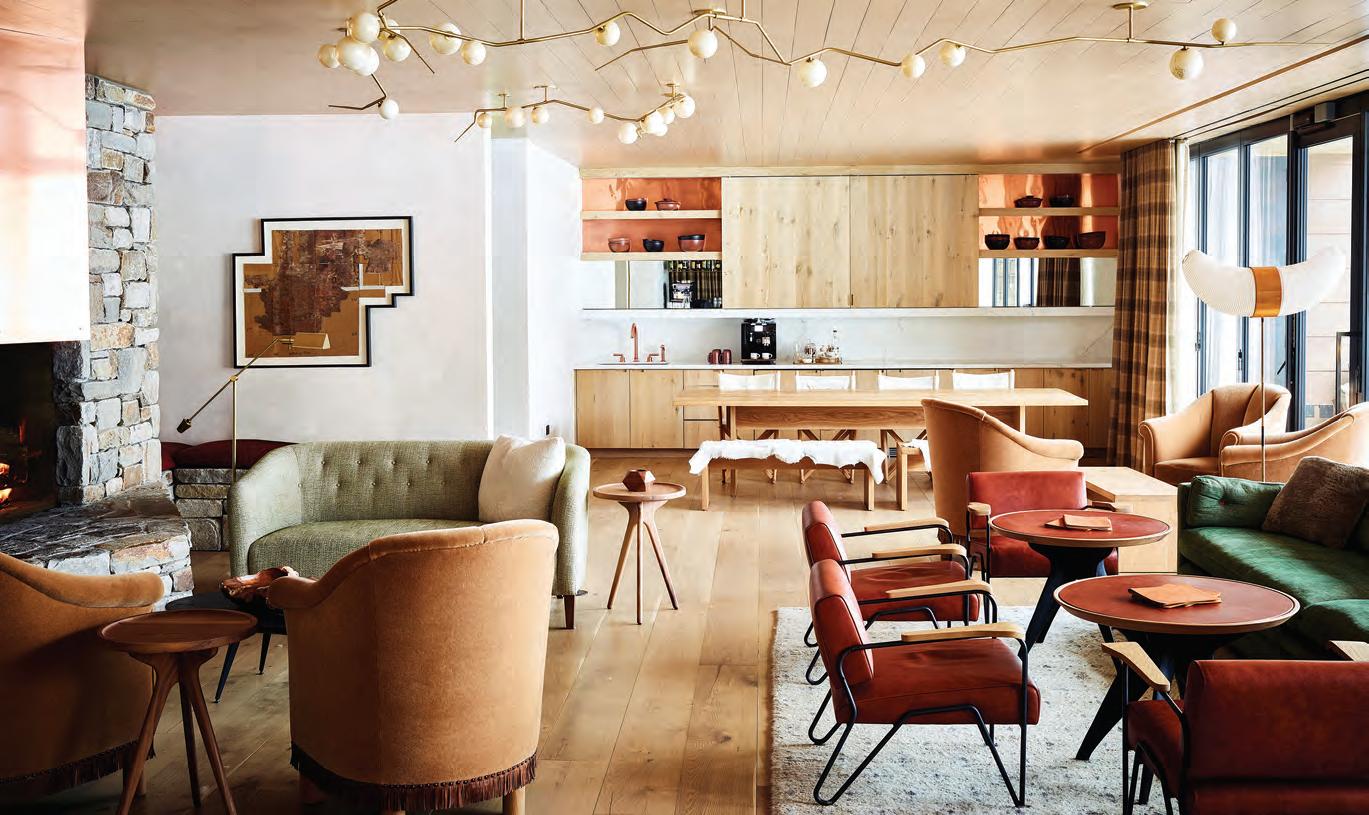
THE SKI RESORT ONE CHOOSES SAYS EVERYTHING ABOUT THEM. FOR EXAMPLE, STYLISH SOCIALITES DESCEND UPON SAINT MORITZ, GSTAAD, AND COURCHEVEL IN EUROPE. BUT TRUE DAREDEVIL SKIERS AND SNOWBOARDERS SWEAR BY THE DEATH-DEFYING JAGGED PEAKS OF JACKSON HOLE.


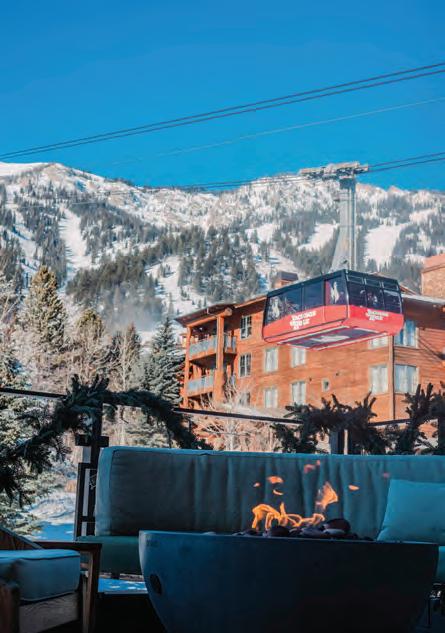
chael Novogratz, David Barry, and Randal Nardone), Edens oversaw everything. His one design directive: no antlers. The result is sleek and modern with a Scandinavian ski chalet-meets-rustic cabin feel. Think red subway tile in the bathroom (a nod to the ski trams), oak paneling, saddle leather headboards for a bit of way-out West flavor, and sturdy wood furniture that is so low slung you can’t help but chill out endlessly by the woodburning fireplace. Each suite’s iPad is fully loaded with music. Beyoncé’s country hit “Texas Hold ’Em” sets the mood as you unpack. The lobby, stocked with every kind of snack you can dream of (endless supply of gummy bears, anyone?) is ground zero for Jackson Hole’s elite—you might run into Gigi Hadid or pro skiers like Bode Miller, Tommy Moe, and Jimmy Chin, all of whom are regulars. For a
yearly fee, you can join Caldera House’s Alpine Club, which includes perks like ski tuning and demos at the Mudroom (the shop run by expert skier Gov Carrington who has an encyclopedic knowledge of everyone and everything in Jackson Hole), a ski valet, and personal use of the high-tech locker rooms which are fully loaded with high-end bath products and rows of glass containers with candy and snacks.
Members can also use the gym and spa, hobnob in the common areas, and have preferred access to the three buzzy restaurants: the grab-and-go Southcable Café (which has the best pizza in town), Shin Shin, a streamlined sushi spot (order the bluefin tuna with osetra caviar and the octopus with kimchi puree), and Corsa, which always has a party atmosphere. With a deep, ox-blood painted
ceiling, scalloped wood trimming, and a carved blonde wood Neapolitan pizza bar, Corsa feels more Cortina than Wyoming. The handmade pastas and trattoria-style Italian dishes are prepared to be shared and the dining room and copper-sided bar are packed every night of the week.
If you decide to leave Caldera House, have dinner at Snake River Grill, which has been around for three decades and serves the fanciest food in town like foie gras torchon with poached rhubarb, tangy lemon jam, and champagne sable; and a Wagyu flank steak from Snake River Farms, with confit potato and red chimichurri. Nearby, the down-home-style Mangy Moose is a Jackson classic—a loud, rowdy saloon-style joint with live music and the must-order Firebird—Southern fried chicken with tangy fire sauce, fried onions,






IF YOU ASK ANY LOCAL WHERE TO GO TO AVOID TOURISTS, THEY WILL DIRECT YOU TO TETON THAI. TUCKED AWAY IN THE VILLAGE AT THE BASE OF THE MOUNTAIN, SOME SAY IT IS BEST THAI FOOD IN THE COUNTRY.
slaw, and bread-and-butter pickles on a brioche bun. But if you ask any local where to go to avoid tourists, they will direct you to Teton Thai. Tucked away in the village at the base of the mountain, some say it is best Thai food in the country. Order every dumpling on the menu and do not miss the pad woon sen—glassy noodles with egg, cabbage, celery, onions, tomatoes, zucchini, and bean sprouts swimming in a thick, sweet-and-spicy prik nam pla sauce made with dried spur chiles. It’s worth overeating because you can always ski off the calories the next day.
You might be tempted to never leave the rustic-chic coziness of Caldera House, but Jackson Hole is all about the mountain—and the snow. Beginners should beware: Jackson Hole is known for rugged terrain and seriously steep
slopes, including the famed Corbet’s Couloir, a double black diamond trail known as one of the most challenging in America. If you’re not exactly Shaun White on a snowboard, the staff (all young, attractive locals) will book a lesson at the Mountain Sports School. It’s about the experience here and you can do everything from heli-skiing, snowmobiling, caribou sleigh rides, fat-tire biking, and a National Elk Refuge sleigh ride. In the warmer months, there is a Yellowstone wildlife safari, ATV rides, horseback riding, and a guided Grand Teton climb. There are also three resorts: Snow King Mountain (small but as steep as a rollercoaster drop) in Jackson, Grand Targhee Resort in Alta, and Jackson Hole Mountain Resort, which is where most people flock.
Pro tip: book way in advance as Jackson Hole
Mountain Resort limits the number of people allowed on the mountain each day. And grab the gondola early so you can experience Corbet’s Cabin, which serves waffles at an elevation of 10,450 feet, oxygen cans not included.


The Savile Row design house, known for its rebellious suits, grows up and moves house, without losing its sense of self.
BY ARIA DARCELLAMenswear label Richard James made a splash on Savile Row in 1992 when it brought a rebellious sensibility to the London street renowned for its tailoring. But even purveyors of fashion need a makeover. After two years—and £2,000,000—the brand has set up shop in a three-story, 2,500-square-foot Georgian town house at 19 Clifford Street, just across the road from Savile Row.
With a fully functional workshop on the premises and exclusive pieces not available at its other locations, the newly opened boutique is a must-visit stop in an area that’s already a destination for sartorially minded men.
To bring the new location to life, the brand tapped architect David Thomas of David Thomas Design. “Working with David was a very similar process to making a bespoke suit: who is it for, what is it for, where is it for, and how can we


make it better?” says Sean Dixon, cofounder and managing director of Richard James. “He was able to fully immerse himself in the story of the brand, capture the unique qualities, and generally enhance the experience for customers.”
Thomas was adamant about respecting the building’s 18th-century exterior and aimed to restore the interior to its former glory. “I spent time with [Richard James] creative director Toby Lamb, going through fabric and press archives which were a great inspiration,” he explains. This led to inventive design choices, like a polka-dot carpet on the main staircase, a chic bar area with custom Stuart Scott stools, and the addition of an internal elevator.
“It was very important to me that it be functional but remain discreet, and of course that the interior design have a ‘wow’ factor,” explains Thomas. “The bronze-clad doors open to reveal a red lacquer paneled interior, inspired by the U.K. telephone boxes of old.”
It is a far cry from the brand’s humble first boutique, which was once described as being no larger than a dressing room. And yet the label was still able to catch the eye of celebrities like Elton John. It’s hard to imagine it won’t have that same irresistible pull now.
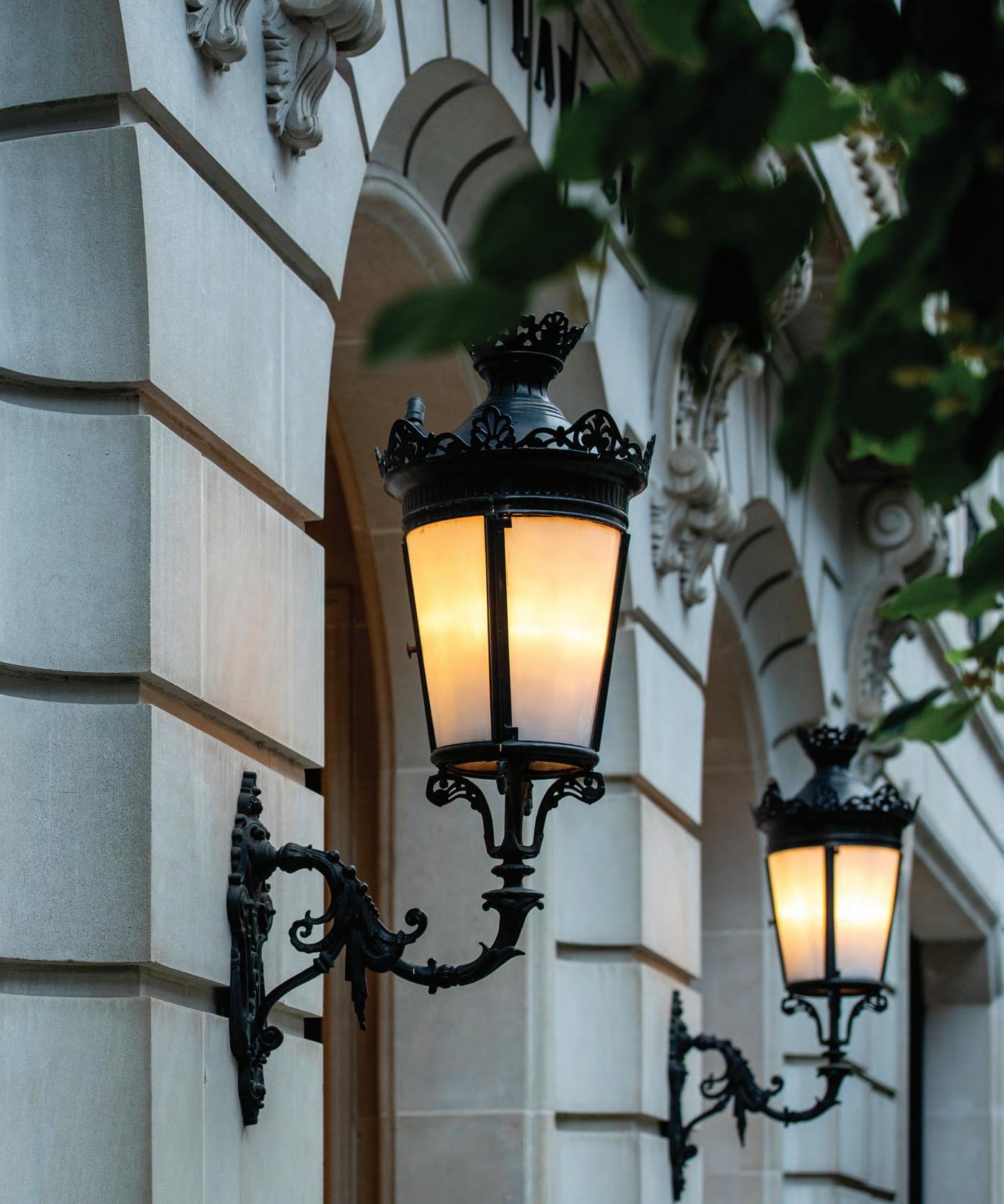

TART, FASHION, AND BUSINESS COLLIDE ON MADISON AVENUE— A ROAD ALREADY RENOWNED F OR ITS ARCHITECTURE AND MUST-VISIT SHOPS.
HISTORIAN GIDEON FINK SHAPIRO TAKES A STROLL DOWN ONE OF MANHATTAN’S MOST ICONIC STREETS AND EXPLAINS HOW IT CAME TO BE.
he stylish soul of upper Madison Avenue can be found between the new Valentino shop at 60th Street—a soaring jewel box of a space, formerly the Calvin Klein flagship, which went through minimalist white and maximalist yellow guises— and the Bellemont condominium building on the corner of 86th Street, a shockingly convincing throwback to the Candela era, but with higher ceilings. Retail bookends the avenue but does not wholly define it: the patrician shops (including my current favorite, the new Hermès boutique at No. 706) accessorize the hotels, apartments, art institutions, and galleries that give Madison its multilayered character. The avenue wasn’t even included on the original Commissioners’ Plan of 1811, which projected Manhattan’s street grid, only coming into existence in 1836 thanks to the real estate developer Samuel B. Ruggles. It’s an odd omission, given that the city is unimaginable without it today.
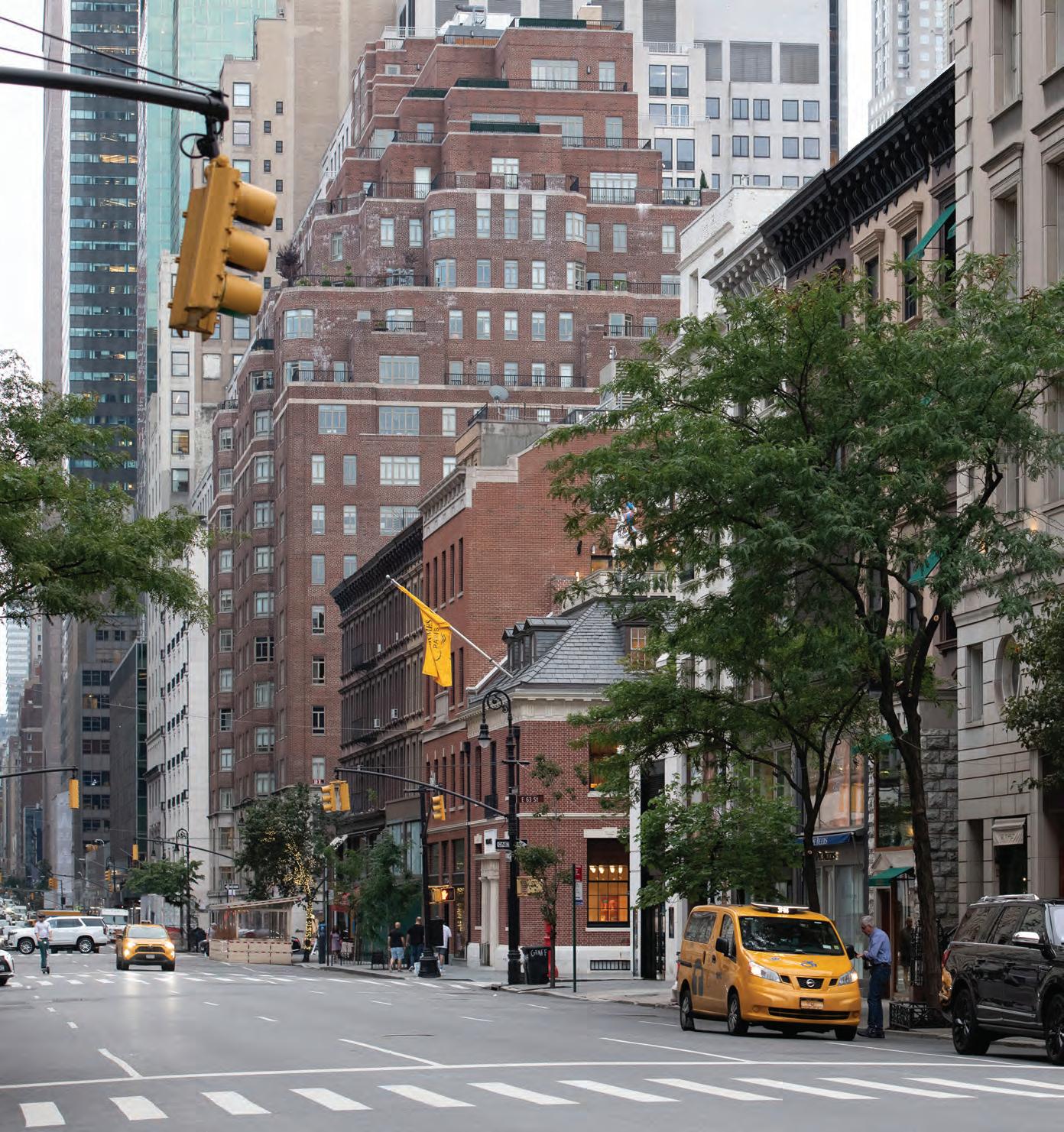



THE AVENUE WASN’T EVEN INCLUDED ON THE ORIGINAL COMMISSIONERS’ PLAN OF 1811, WHICH PROJECTED MANHATTAN’S STREET GRID, ONLY COMING INTO EXISTENCE IN 1836
THANKS TO THE REAL ESTATE DEVELOPER SAMUEL B. RUGGLES.
TODAY, THE CITY IS UNIMAGINABLE WITHOUT IT.

To me, the avenue reaches an apex in the vicinity of East 75th Street, where the aggressively blocky architecture of the old Whitney Museum issues a challenge that was never answered, but instead subsumed into the fabric of the Upper East Side and the culture of New York. The inverted ziggurat designed by Marcel Breuer opened in 1966 and was once described as the most hated building in the neighborhood. Now, it’s the pinnacle of high-art glamour with impeccable provenance, having served as home to the Met Breuer and, until recently, the Frick Madison. This tripledistillation process has prepared the vintage Brutalist landmark for its next life as an auction house and VIP gallery for Sotheby’s.
The presence of art institutions on Madison at once offsets and reinforces the reign of commercial capital. And this is not just about the Whitney-Met-FrickSotheby’s extravaganza at No. 945. Many people forget that Sotheby’s, from 1964 to 1980, was based just a few doors up the avenue—in the former Parke-Bernet Galleries, the unlovely 1949 post-Deco pile at No. 980, which has subsequently housed Larry Gagosian’s uptown outpost and other A-list galleries. (Incidentally, Gagosian et al. are vacating to make room for Bloomberg Philanthropies—a splash-in-the-face reminder that it’s all just real estate, after all.) Just another block up, the London-based White Cube gallery recently conquered the demure
federalist-style building next to Sant Ambroeus. And between 78th and 79th Streets is Alexander Calder’s Sidewalk, a public gift of patterned pavement that still feels exciting more than 50 years after its installation.
The quiet granddaddy of them all, open by appointment only, is tucked around the corner in the town house at 18 East 77th Street: the Castelli Gallery, which gave modernist luminaries like Jasper Johns, Roy Lichtenstein, and Frank Stella their first solo shows. Back then, Castelli was based a few doors west, in another limestone town house, where today the Michael Werner Gallery presents the work of artists like Maki Na Kamura and Piero Manzoni. It’s all part of the shapeshifting power nexus of art on Madison.
Modern art galleries may have led the way in pairing traditional exteriors with sleek interiors. It’s a formula adopted successfully by the Mark hotel, which presides over the corner of Madison and 77th Street with its classically understated 1920’s facade and opulent Jacques Grange-designed contemporary interiors. It’s the same with the Apple store on the corner of 74th Street. At a glance, you understand how the company has deployed the pristine architectural shell of a neoclassical limestone palace (a former bank) as a foil for branded commercial interiors. Despite Apple’s minimalist style, its shop at No. 940 is above all an homage to… Ralph Lauren.

MADIS ON IS ABOUT REAL ESTATE, BUT ALSO ABOUT MEMORIES AND, IN BETWEEN CRUSHING TORRENTS OF CAPITAL, FASCINATING ENCOUNTERS WITH AR T AND ARCHITECTURE.
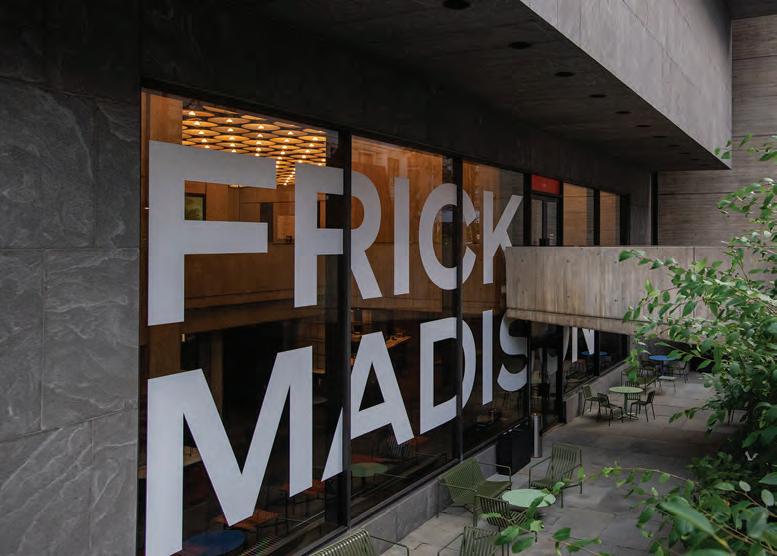

It was 1983 when Ralph took the risk of leasing the sumptuous but languishing French Renaissance Revival château on the corner of 72nd Street, built in 1898 for Gertrude Rhinelander Waldo, melding history with fantasy to create a nonpareil expression of brand identity. I have friends who describe this place as formative, even life-changing. Madison is about real estate, but also about memories and, in between crushing torrents of capital, fascinating encounters with art and architecture.
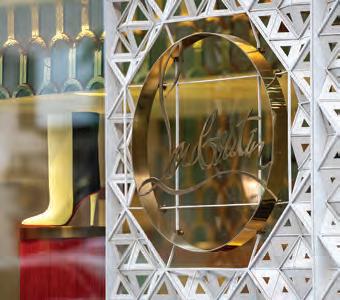
A
TO EVERYTHING AND ANYTHING YOU MAY NEED TO FIND ON MADISON AVENUE.
THE WHO, WHERE, AND HOW ( TO CONTACT) FOR ONE OF NEW YORK’S CHICEST STREETS.
Cora

Dalva
L’Antiquaire
Nicholas
S.J.

Acquavella
Arader Galleries
1016 Madison Avenue 212-628-7625
Barbara Mathes Gallery
22 East 80th Street, 3rd Floor 212-570-4190
Barrington Fine Arts 686 Madison Avenue 917-261-7360
Bookstein Projects
39 East 78th Street, 4th Floor 212-750-0949
Castelli Gallery
18 East 77th Street 212-249-4470
Ceysson & Bénétière
956 Madison Avenue, 2nd Floor 646-678-3717
Christopher Bishop Fine Art 1046 Madison Avenue, Suite 2N 212-249-2118
Conner Rosenkranz
19 East 74th Street 212-517-3710
Corporate Art Directions
41 East 57th Street, 8th Floor 212-355-5370
Daniel Crouch Rare Books
24 East 64th Street 212-602-1779
David Benrimon Fine Art
41 East 57th Street, 2nd Floor 212-628-1600
David Nolan Gallery
24 East 81st Street, 4A New York, NY 10028 212-925-6190
Debra Force Fine Art 13 East 69th Street, Suite 4F 212-734-3636
DFN Projects
16 East 79th Street, Garden Level 212-884-8040
Di Donna Galleries 744 Madison Avenue 212-259-0444
Dickinson 980 Madison Avenue 212-772-8083
Didier Aaron 32 East 67th Street 212-988-5248
Edward Tyler Nahem 980 Madison Avenue 212-517-2453
Emma Scully Gallery 16 East 79th Street 929-240-4257
Eykyn Maclean 23 East 67th Street 212-772-9425
Franklin Parrasch Gallery 19 East 66th Street 212-246-5360
Freedman Art 25 East 73rd Street 212-249-2040
Gagosian 980 Madison Avenue 212-744-2313
Galerie Buchholz 17 East 82nd Street 212-328-7885
Galerie Gmurzynska 43 East 78th Street 212-535-5275
Galerie Mourlot 16 East 79th Street 212-288-8808
Gerald Peters Gallery 24 East 78th Street 212-628-9760
Gitterman Gallery 3 East 66th Street, 1B 212-734-0868
Goodman Gallery 23 East 67th Street, No. 1A 347-249-8994
Graham Shay 1857 34 East 67th Street, 3rd Floor 212-535-5767
Gray 1018 Madison Avenue, 4th Floor 212-472-8787
Hauser & Wirth 32 East 69th Street 212-794-4970
Helly Nahmad Gallery 975 Madison Avenue 212-879-2075
Helwaser Gallery 833 Madison Avenue, 3rd Floor 646-476-7760
Henrique Faria Fine Art
35 East 67th Street, 4th Floor 212-517-4609
Hirschl & Adler Galleries
41 East 57th Street, 9th Floor 212-535-8810
Howard Greenberg Gallery 41 East 57th Street, Suite 801 212-334-0010
Howard Shaw Fine Art 18 East 64th Street, Suite 4F 917-797-1291
Hubert Gallery 16 East 79th Street 212-628-2922
Hugo Galerie 755 Madison Avenue 212-614-6983
Ippodo Gallery 32 East 67th Street 212-967-4899
James Goodman Gallery 41 East 57th Street, Suite 802 212-593-3737
James Sansum 155 East 71st Street 917-912-4363
Jane Kahan Gallery 922 Madison Avenue, Mezzanine 212-744-1490
James McCoy Gallery 41 East 57th Street, 11th Floor 212-319-1996
Jennifer Baahng 790 Madison Avenue 212-255-2177
Joan B Mirviss 39 East 78th Street, Suite 401 212-799-4021
John Szoke Gallery 17 West 54th Street, 1 C/D 212-219-8300
Kapoor Galleries 34 East 67th Street 212-794-2300
Kate Oh Gallery 31 East 72nd Street 646-286-4575
Keith de Lellis Gallery 41 East 57th Street, Suite 703 212-327-1482
Kraushaar Galleries 15 East 71st Street, Suite 2B 212-288-2558
Kristen Lorello 23 East 73rd Street, 5th Floor 212-287-4020
L. Parker Stephenson Photographs 764 Madison Avenue 212-517-8700
Leila Heller 22 East 80th Street, Ground Level 212-249-7695
Leo Koenig 958 Madison Avenue, 3rd Floor 212-334-7866
Leon Tovar Gallery 26 East 64th Street, 2nd Floor 212-585-2400
Les Enluminures 23 East 73rd Street, 7th Floor 212-717-7273
Leslie Feely 1044 Madison Avenue 917-288-8120
Lévy Gorvy Dayan 19 Eat 64th Street 212-772-2004
Lincoln Glenn 17 East 67th Street, Suite 1A 646-764-9065
Lois Wagner Fine Arts 15 East 71st Street, Suite 2A 212-396-1407
Luxembourg + Co. 595 Madison Avenue, 6th Floor 212-452-4646
Mary-Anne Martin Fine Art
23 East 73rd Street 212-288-2213
Mignoni 960 Madison Avenue 212-744-8200
Miyako Yoshinaga 24 East 64th Street 212-268-7132
Mnuchin Gallery 45 East 78th Street 212-861-0020
Moeller Fine Art 35 East 64th Street 212-644-2133
Nahmad Contemporary 980 Madison Avenue, 3rd Floor 646-449-9118
Opera Gallery 791 Madison Avenue 646-707-3299
Petzel Gallery 35 East 67th Street 212-680-9467
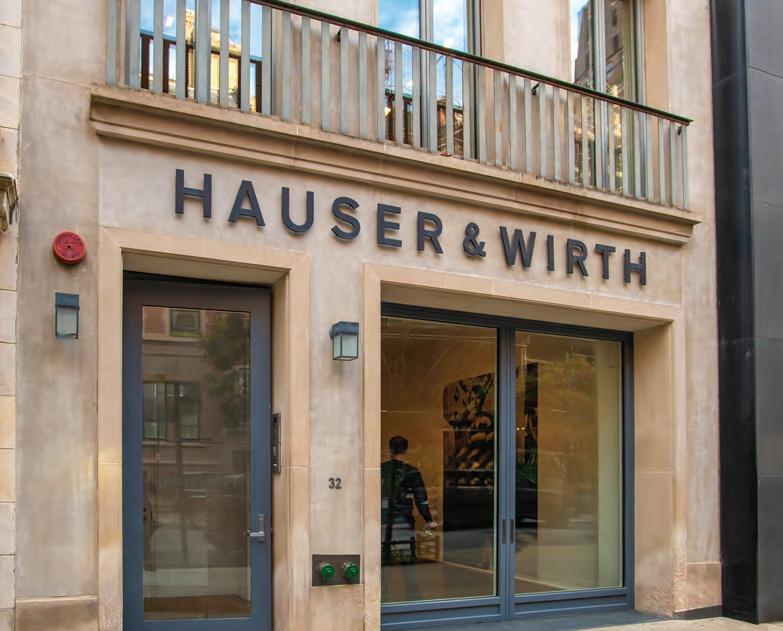
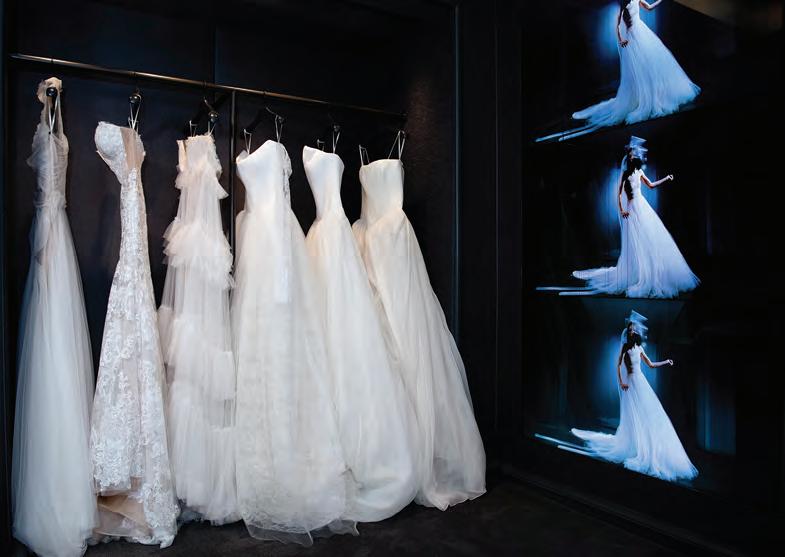
Rafael Gallery 1020 Madison Avenue 212-744-8988
Robilant+Voena
980 Madison Avenue, Suite 303 917-409-0549
Rosenberg & Co.
19 East 66th Street 212-202-3270
Saffronart 595 Madison Avenue, Suite 1207 212-627-5006
Schweizer Premodern
39 East 78th Street 212-446-6751
Shepherd W & K Galleries
58 East 79th Street 212-861-4050
Sigrid Freundorfer
Fine Art 790 Madison Avenue, Suite 602 212-517-9700
Skarstedt Gallery 20 East 79th Street 212-737-2060
Soufer Gallery 1015 Madison Avenue, Suite 501 212-628-3225
Sous Les Etoiles Gallery 16 East 71st Street 646-329-6679
Spanierman Modern 958 Madison Avenue, 2nd Floor 212-249-0619
Sprüth Magers 22 East 80th Street, 2nd Floor 917-722-2370
Stellan Holm Gallery 60 East 92nd Street 212-627-7444
Thomsen Gallery 9 East 63rd Street 212-288-2588
Upsilon Gallery 23 East 67th Street 646-476-4190
Van Doren Waxter 23 East 73rd Street 212-445-0444
Vanità Gallery 19 East 69th Street, 3rd Floor 212-472-1106
White Cube 1002 Madison Avenue 212-750-4232
Yoshii Gallery 833 Madison Avenue 212-744-5550
Assouline 25 East 77th Street 212-744-4300
Gagosian Shop 976 Madison Avenue 212-796-1224
Imperial Fine Books 790 Madison Avenue, 6th Floor 212-861-6620
James Cummins Bookseller 699 Madison Avenue, 7th Floor 212-688-6441
Kosciuszko Foundation 15 East 65th Street 212-734-2130
Ursus Books & Gallery 50 East 78th Street, Suite 1C 212-772-8787
Bonpoint 805 Madison Avenue 212-879-0900
Dolce & Gabbana
Children’s Boutique 820 Madison Avenue 646-767-9171
Il Gufo 997 Madison Avenue 917-639-3867
Anne Barge 766 Madison Avenue, 2nd Floor 646-344-1994
Flora on Madison 766 Madison Avenue 212-242-6160
Vera Wang 991 Madison Avenue 212-628-3400
Little Eric 1118 Madison Avenue 212-717-1513
Marie-Chantal 960 Madison Avenue 646-920-1321
Monnalisa 1088 Madison Avenue 646-892-3301
Ralph Lauren Baby 872 Madison Avenue 212-434-8083
Ralph Lauren Children 878 Madison Avenue 212-606-3376
Spring Flowers
Children’s Boutique 905 Madison Avenue 212-717-8182
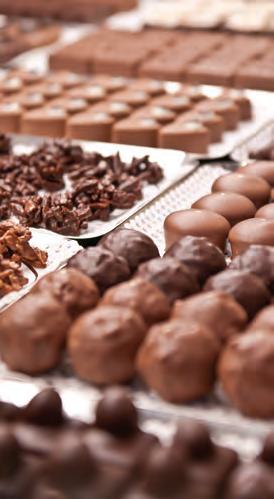
La Maison du Chocolat 1018 Madison Avenue 212-744-7117
Teuscher 25 East 61st Street 646-952-0112

Oliver



Brunello Cucinelli
683–689 Madison Avenue 212-813-0900
Canali
600 Madison Avenue 212-752-3131
Carolina Herrera 954 Madison Avenue 212-249-6552
Cartolina 966 Madison Avenue 917-409-0035
Celine 650 Madison Avenue 212-535-3703
Cesare Attolini
798 Madison Avenue
646-707-3006
CH Carolina Herrera
802 Madison Avenue 212-744-2076
Chanel
737 Madison Avenue 212-535-5505
Chloé 715 Madison Avenue 646-560-3800
Darina Byrne Wardrobe
Guru 790 Madison Avenue, Suite 500 917-596-4506
David Lance New York
19 East 71st Street, 3rd Floor 212-879-8686
Eleventy 769 Madison Avenue 212-931 -0662
Elie Saab 860 Madison Avenue 212-933-4566
Elyse Walker 926 Madison Avenue 917-722-2266
Epperson Studio
40 East 58th Street 646-600-2459
Eton
833 Madison Avenue 646-455-0131
Etro 720 Madison Avenue 212-317-9096
Everything But Water 1060 Madison Avenue 212-249-4052
Davide Cenci 1041 Madison Avenue 212-628-5910
de Corato Atelier 819 Madison Avenue, 5th Floor 212-535-3003
Delle Celle 17 East 67th Street 212-744-5820
Dennis Basso 34 East 57th Street 212-794-4500
Dolce & Gabbana 827 Madison Avenue 212-249-4100
Felix 1069 Madison Avenue 917-261-6957
Fendi 595 Madison Avenue 212-897-2244
Fivestory 1044 Madison Avenue 212-288-1338
Frame 900 Madison Avenue 646-568-4706
Frances Valentine 922 Madison Avenue 212-452-2681

Gabriela Hearst 985 Madison Avenue 212-433-4499
Generation Love
804 Madison Avenue 212-915-7157
Giorgio Armani 760 Madison Avenue 212-988-9191
Givenchy
625 Madison Avenue 212-650-0180
Golden Goose 941 Madison Avenue 212-249-0693
Hermès 706 Madison Avenue 212-751-3181
IRO
1013 Madison Avenue 212-570-2200
Isabel Marant 677 Madison Avenue 212-249-2019
Jenni Kayne 1082 Madison Avenue
646-647-8410
John Elliott 853 Madison Avenue 917-522-3931
Johnny Was 1070 Madison Avenue 646-992-3182
Kirna Zabête 943 Madison Avenue 646-410-0025
Kiton 692 Madison Avenue 917-672-2638
La Ligne 996 Madison Avenue 212-879-7000
Lafayette 148 956 Madison Avenue 914-600-8776
L’Agence 1011 Madison Avenue 212-391-9291
Maria Cher 1071 Madison Avenue
917-581-2257
Marina Rinaldi 815 Madison Avenue 212-734-4333
Marni 822 Madison Avenue 212-257-6907
Max Mara 813 Madison Avenue 212-879-6100
Michael Kors Collection 790 Madison Avenue 212-452-4685
Missoni 676 Madison Avenue 212-517-9339
Monique Lhuillier 818 Madison Avenue
Morgane Le Fay 743 Madison Avenue

Lanvin 855 Madison Avenue 646-439-0381
Loro Piana 748 Madison Avenue 212-980-7961
LoveShackFancy 1058 Madison Avenue 917-388-2035
Ludivine 764 Madison Avenue 212-249-4053
James
Mackage 814 Madison Avenue 646-741-2286
N.Peal 952 Madison Avenue
Nardos Design 807 Madison Avenue 917-283-2622
Orlebar Brown 987 Madison Avenue 212-535-5355
Oscar de la Renta 772 Madison Avenue 212-288-5810
Paige 958 Madison Avenue 646-531-4086

Prada 841 Madison Avenue 212-327-4200
Rag & Bone 11 East 68th Street 646-517-7586
Ralph Lauren 867 Madison Avenue 212-606-2100
Ralph Lauren 888 Madison Avenue 212-434-8000
Ramy Brook 980 Madison Avenue 646-422-1177
Reformation 1055 Madison Avenue 646-921-0221
Rene 927 Madison Avenue 212-879-8889
Roller Rabbit 1156 Madison Avenue 212-772-7200
Rubin & Chapelle 964 Madison Avenue 917-409-0649
Serapian 785 Madison Avenue 332-204-1163
Sermoneta Gloves 609 Madison Avenue 212-319-5946
St. John 655 Madison Avenue 212-755-5252
Suitsupply 635 Madison Avenue 917-336-5490
Tom Ford 672 Madison Avenue 212-359-0300
Valentino 654 Madison Avenue 212-772-6969
Veronica Beard 988 Madison Avenue 646-930-4746
Veronica De Piante 833 Madison Avenue 646-360-2554
Versace 747 Madison Avenue 212-735-9100
Sunspel 781 Madison Avenue 646-998-5999
Susan van der Linde 34 East 67th Street 212-758-7500
Taji Fashions 675 Madison Avenue 212-838-2490
Tanya Taylor 980 Madison Avenue 212-837-2785
The Armoury 13 East 69th Street 646-613-7614
The Row 17 East 71st Street 212-755-2017
The Westside 1162 Madison Avenue 212-535-4281
Tincati Milano 20 East 67th Street 212-308-0168
Vilebrequin 1007 Madison Avenue 212-650-0353
Vince 980 Madison Avenue, Space A 646-777-5154
Vuori 1153 Madison Avenue 212-249-1302
Zadig & Voltaire 1133 Madison Avenue 646-963-2006
Zadig & Voltaire Flagship 845 Madison Avenue 845-244-6660
Zimmermann 900 Madison Avenue 212-486-8080
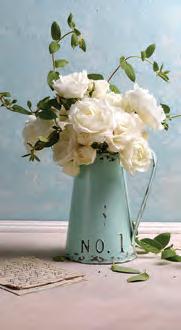



Frederic Fekkai at the Mark
25 East 77th Street 212-396-4600
Hair Extensions Manhattan 22 East 82nd Street 212-737-7441
John D’Orazio Salon 872 Madison Avenue, Suite 2B 212-628-5646
John Frieda Salon
30 East 76th Street, Suite 2B 212-879-1000
Louise O’Connor Salon 33 East 61st Street, 3rd Floor 212-935-6261
Madison Avenue Salon 1127 Madison Avenue 212-535-0796
Madison on Madison 39 East 78th Street, 6th Floor 917-854-8122
Roman K Salon 1063 Madison Avenue, 2nd Floor 212-628-7505
Salih Salon 20 East 67th Street 212-249-0143
Samuel Shriqui Salon 37 East 65th Street, Ground Floor 212-472-6805
Shuki Zikri 19 East 76th Street 917-409-0717
Stephen Knoll Salon 19 East 62nd Street, 2nd Floor 212-421-0100
Toka Salon and Day Spa 601 Madison Avenue, 5th and 6th Floors 212-517-5133
Valery Joseph Salon 1044 Madison Avenue, 2nd Floor 212-517-2333
Warren Tricomi Haircare 969 Madison Avenue, 4th Floor 212-262-8899
Yves Durif Salon 35 East 76th Street, 3rd Floor 212-452-0954
Boaz Studios 29 East 73rd Street 212-988-8578
Core Fitness 12 East 86th Street 212-327-4197
E by Equinox 30 East 85th Street 212-501-1490
KOOP Strength and Wellness 605 Madison Avenue, 4th Floor 646-795-4598
Park East Pilates 58 East 79th Street 212-717-8825
ReBalance 635 Madison Avenue, Suite 1400 212-380-1764
Rosenberg Wellness Center 635 Madison Avenue, 4th Floor 212-858-0015
Uptown Pilates 905 Madison Avenue 212-717-3903
Wellness+
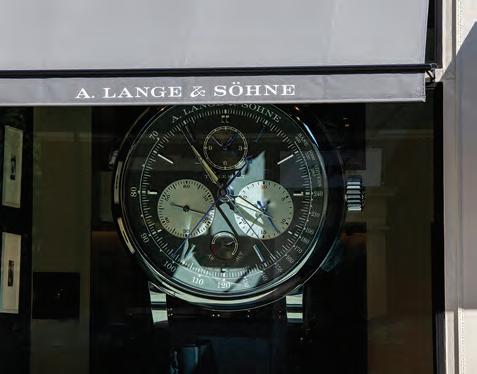
Camilla


Chrome Hearts
870 Madison Avenue 212-794-3100
David Webb 942 Madison Avenue 212-421-3030
De Beers 716 Madison Avenue 212-906-0001
Djula 922 Madison Avenue 646-869-9585
Eleuteri
780 Madison Avenue 646-649-5769
Elizabeth Locke Jewels 968 Madison Avenue 212-744-7878
FD Gallery 26 East 80th Street 212-772-2440
Fred Leighton 773 Madison Avenue 212-288-1872
Graff 710 Madison Avenue 212-421-3605
Ilias Lalaounis 31 East 64th Street 212-439-9400
Ippolita 721 Madison Avenue 646-664-4240
Irene Neuwirth 937 Madison Avenue 212-419-9162
Jaded Jewels 1048 Madison Avenue 212-288-6631
Jaeger-LeCoultre 729 Madison Avenue 646-828-4328
Kwiat 773 Madison Avenue 212-725-7777
Little Words Project 1055 Madison Avenue 917-909-6976
Marina B 18 East 67th Street, Suite 2A 212-510-8169
Marlo Laz 965 Madison Avenue 646-678-3404
Michael Ashton 1022 Madison Avenue 212-517-6655


Montblanc 635 Madison Avenue 212-223-8888

Nina Runsdorf 20 East 69th Street, Suite 3A 212-382-1243
Panerai 711 Madison Avenue 212-223-1562
Paul Morelli 725 Madison Avenue 212-585-4200
Pomellato 741 Madison Avenue 212-879-2118
Reinstein Ross 21 East 67th Street 212-226-4513
Ring Concierge 946 Madison Avenue 917-540-5298
Seaman Schepps 824 Madison Avenue 212-753-9520
Sidney Garber 998 Madison Avenue 212-274-1111
Stephen Russell 970 Madison Avenue 212-570-6900
Studs 41 East 78th Street 646-663-4317
Twain Time 19 East 69th Street 212-256-0303
Vhernier 994 Madison Avenue 332-267-2900
WatchBox 595 Madison Avenue, 4th Floor 646-461-4880
Wrist Aficionado 19 East 62nd Street 212-422-2600
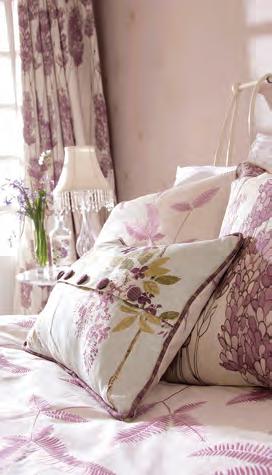
Frette
806 Madison Avenue 212-988-5221
Schweitzer Linens
1097 Madison Avenue 212-249-8361
Yves Delorme
1070 Madison Avenue 212-256-0926
Agent Provocateur 675 Madison Avenue 212-840-2436
Peress Lingerie 1070 Madison Avenue 212-861-6336
Wolford 609 Madison Avenue 212-688-4850
Wolford 997 Madison Avenue 646-559-2635
The Madison Apothecary 1114 Madison Avenue 212-249-1069
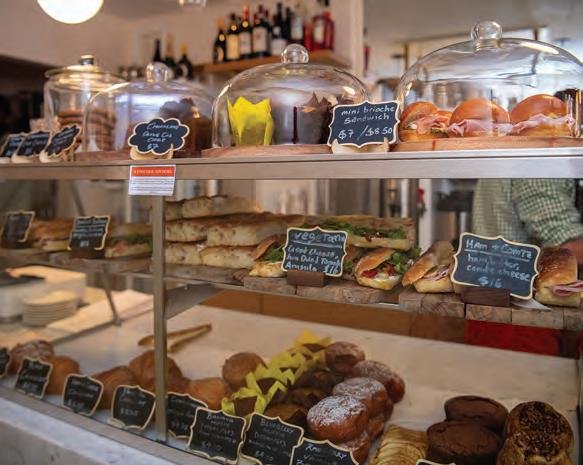
Altesi 26 East 64th Street 212-759-8900
Amaranth Restaurant
21 East 62nd Street, Ground Floor 212-980-6700
Avena
22 East 66th Street 646-596-8447
Bar Italia
768 Madison Avenue 917-546-6676
Bel Ami
30 East 68th Street 212-737-1313
Café Carlyle 981 Madison Avenue 212-744-1600
Caravaggio
23 East 74th Street 212-288-1004
Come Prima Ristorante 903 Madison Avenue 212-517-7700
E.A.T.
1064 Madison Avenue 212-772-0022
Eli’s 922 Madison Avenue 646-790-2333
Fleming by Le Bilboquet
27 East 62nd Street 646-490-4950
Green Cafe 36 East 58th Street 212-355-3311
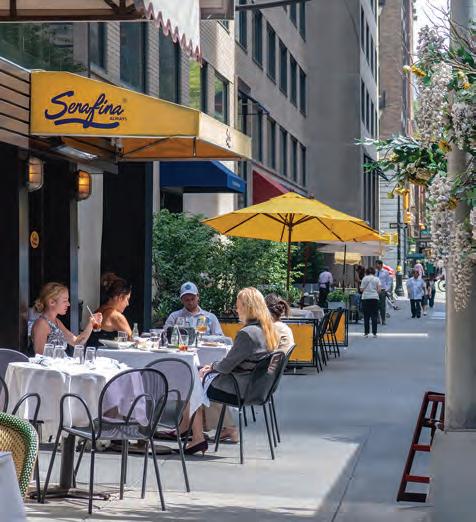
Il Mulino 37 East 60th Street 212-750-3270
Kappo Masa 976 Madison Avenue 212-906-7141
La Goulue 29 East 61st Street 212-988-8169
Le Charlot 19 East 69th Street 212-794-6419
Majorelle at the Lowell 28 East 63rd Street 212-935-2888
Marky’s Madison 1067 Madison Avenue 212-288-0850
Match 65 Brasserie 29 East 65th Street 212-737-4400
Nectar 1090 Madison Avenue 212-772-0916
Nello 696 Madison Avenue 212-980-9099
Philippe by Philippe Chow 33 East 60th Street 212-644-8885
Poppi 20 East 69th Street 212-209-6181
Sant Ambroeus 1000 Madison Avenue 212-570-2211
Serafina 38 East 58th Street 212-832-8888
Serafina 33 East 61st Street 212-702-9898
Serafina
1022 Madison Avenue 212-734-2676
Sistina 24 East 81st Street 212-861-7660
Starbucks 1142 Madison Avenue 212-288-1506
The SisterYard 945 Madison Avenue 305-527-3993
Tao Uptown 42 East 58th Street 212-888-2288
Three Guys Restaurant 960 Madison Avenue 212-628-8108
Via Quadronno 25 East 73rd Street 212-650-9880
Viand 673 Madison Avenue 212-751-6622

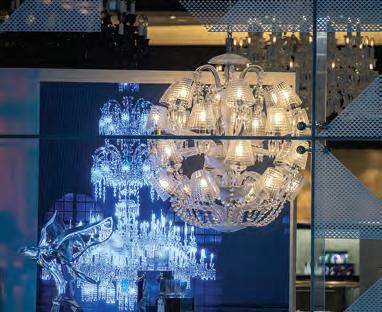

JJ Eyelashes 905 Madison Avenue 212-517-5522
Gianvito
Jimmy
John
Manolo
Berluti

Avenue 212-645-7070
Introstem 1118 Madison Avenue 646-476-5080
Kimara Ahnert 1095 Madison Avenue 212-452-4252
Klara Beauty Lab 50 East 78th Street 212-390-0239
LaFonde Boutique 811 Madison Avenue 646-609-2258
La Maison Valmont 35 East 76th Street 646-891-4947
Luxura 625 Madison Avenue, Suite 1103 888-859-4772
Ora 1114 Madison Avenue 646-478-7100
Vicki Morav 19 East 71st Street, Ground Floor 212-744-4753
Mrs. John L. Strong 699 Madison Avenue, 5th Floor 212-838-3775




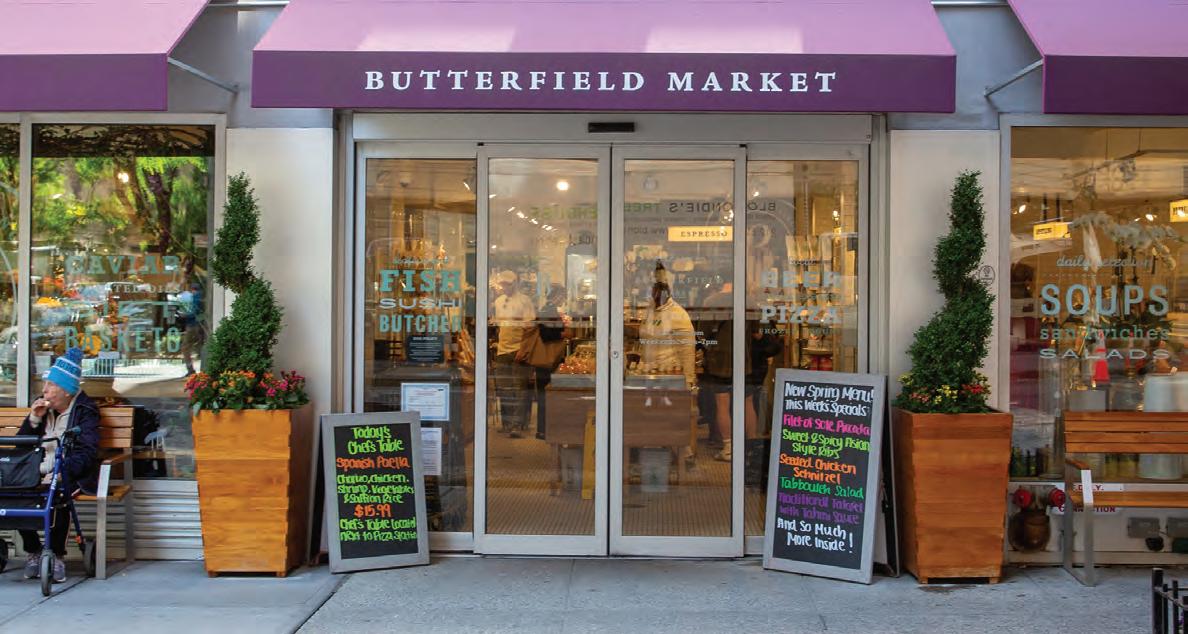



Butterfield Market has been a provider of top-tier quality foods to New York City residents since 1915. As a third-generation family owned business, we hold dear the values of warm, friendly service, meticulous attention to detail, and, above all, the creation of a memorable culinary experience. Specializing in an array of offerings including prepared foods, unique produce, baked goods, coffees and tea, specialty items, flowers, sushi, soups, butcher, seafood, and more, our aspiration is to curate and deliver the very best of NYC to our valued customers.


MADISON AVENUE IS BACK—AND BOOMING, DISCOVERS BETH LANDMAN. WITH NAMES LIKE GIORGIO ARMANI AND NOBU LAYING THEIR STYLISH STAKE ON THE FABLED BOULEVARD, THE STRIP FROM 57TH TO 72ND STREET HAS NEVER BEEN HOTTER.
Madison Avenue is back in a big way. Just a few years ago, the iconic row, long home to some of the most prestigious fashion houses and jewelers, as well as museums and high-end hotels, suffered in the wake of the pandemic, with 55 empty storefronts on the golden stretch between 57th and 72nd Street. But now all that has changed and the boulevard is at the center of some of the city’s chicest new projects, including the new Giorgio Armani Residences, the Surrey hotel, and the Plaza Athénée Nobu Hotel & Spa New York.
“Madison has always evoked a European elegance and charm that rivals streets in Paris or Florence, and there is an intimate scale to many of its buildings,” observes Susan de França, president and CEO of Douglas Elliman Development Marketing. “It’s very much a walking avenue where you can go into world-class boutiques, galleries, and restaurants.”
One of fashion’s biggest names, Giorgio Armani will not only bring his store to Madison Avenue this summer, he will also offer 10 bespoke luxury residences upstairs. The bronze-accented fluted limestone facade alone has been stopping New Yorkers in their tracks already.
Located at 760 Madison, on 65th Street, and currently under development in partnership with SL Green Realty, these are the first resi -


THE HOMES ARE AS LUXURIOUS AND STATUESQUE AS AN ARMANI PRIVÉ COUTURE GOWN, WITH 10-FOOT CEILINGS AND EIGHTFOOT WINDOWS. THE BUILDING WILL HAVE A TEA LOUNGE, LIBRARY, SPA TREATMENT ROOM, AND AN ARMANI RESTAURANT.
dences where Armani has personally shepherded the design, which he is doing in collaboration with the architecture firm CookFox and renowned interior designer Victoria Hagan. There are fourand five-bedroom apartments that sprawl over 4,500 square feet, along with a few two- and three-bedroom units. There is also a fifth-floor home with an oversized terrace and two balconies off the bedrooms. Bronze detailing is brought inside on fixtures to mimic the building’s front. There is, of course, that unmistakable classic, understated Armani neutral palate. Primary bathrooms are
elevated with rosa aurora marble. The homes are as luxurious and statuesque as an Armani Privé couture gown, with 10-foot ceilings and eight-foot windows, many of them rounded to give a more expansive vista. “The light is just gorgeous; you have amazing views up and down the avenue and on the upper floors you can see the park,” gushes Sabrina Saltiel of Douglas Elliman, who is heading the sales team with Madeline Hult Elghanayan and has only four remaining apartments on the market. The building will have a tea lounge, library, spa treatment room, and an Armani restaurant.
“MADISON HAS ALWAYS EVOKED A EUROPEAN ELEGANCE AND CHARM THAT RIVALS STREETS IN PARIS OR FLORENCE.”
–SUSAN

In the face of so many over-the-top amenities in new buildings—from dog spas to virtual golf gaming rooms—these residences rest more on their elegance and prime location.
“People asked if we have a golf simulator,” sighs Saltiel. “No! This is for the buyer who wants privacy.”
The Surrey’s much anticipated renaissance in its longtime home at 20 East 76th Street will be the first Corinthia hotel in the U.S.—a combination of 70 guest rooms, 30 suites, and 14 residences. It is due to be unveiled this summer. Its development is in partnership with the Reuben Brothers, who
are also behind the former iconic Chesterfield in Palm Beach, to be rebranded as the Vineta Hotel this year.
The history of the 16-story Surrey, originally built in 1926 and host to such glamorous guests as JFK and Bette Davis, contributes to the hotel’s appeal. “The Surrey has been part of the Upper East Side for nearly 100 years, and the community in the neighborhood is a piece of what drew Corinthia to the hotel,” explains Pradeep Raman, the hotel’s managing director.
Designer Martin Brudnizki will oversee its new


incarnation, including four signature suites inspired by Central Park’s bridges. Gone is the much-loved Café Boulud from the Surrey, but Corinthia has brought in buzzy Casa Tua, the hot hospitality group that started in Miami with a stylish Italian dining and gathering spot, before branching out to Aspen and Paris. It will also open a restaurant, lounge, and members’ club on the property.
Nobu, which began in New York as a restaurant before expanding to hotels from Marbella to Marrakesh, will return, partnering with Asset World Corporation to transform the former Plaza Athénée’s nearly century-old building off Madison into its first hotel in this city. Due in 2026, the Plaza
Athénée Nobu Hotel & Spa New York will encompass 145 rooms, as well as suites with indoor and outdoor glassed terraces and gazebos. It will, of course, have an omakase dining offering, along with a Japanese wellness center and rooftop with spectacular views for private parties.
De França says that despite a setback from escalated interest rates, the Upper East Side has been gaining momentum over the last 12 months. “There are all these new projects coming up, and many of the younger generation wanted to be downtown but now you see a lot of them who want to be back where they grew up—in a safe, convenient environment. Uptown is cool again.”

Sandy Linter’s love of makeup blossomed early. When she was a kid in the 1960s, she was bewitched by images she saw in her mother’s issues of Vogue, Harper’s Bazaar, and Glamour. “Magazines ruled in those days,” Linter says. “I would just stare at the pages of the fashion magazines, and I would copy it on my friends or my mom or myself.” It was a fun form of expression for a 14-year-old girl. The idea of doing makeup professionally didn’t occur to her for years.
Born Sandra Gilman in Brooklyn, Linter grew up on Staten Island, where there was, as she asserts in her delicious New York accent, “the most gorgeous Italian population. The guys were the hottest guys, and I went through my fair share.” But as hot as they were, she had to get to Manhattan.
Even though she knows how to type and take shorthand, Linter’s secretarial beginnings went nowhere. She credits her husband at the time, Adam Linter, with encouraging her to follow her passion for makeup. Within four years, she had earned her license, gotten a job with legendary hair stylist Mr. Kenneth in his iconic town house salon, and started doing gigs for Vogue. Though her marriage to Linter ended, she kept the last name with his blessing and built a career that became the love of her life.
In 1980, she published a book on evening makeup called Disco Beauty. In the early aughts, she had a contract with Lancôme. Keeping a decidedly quieter schedule now in her mid-70s, she still enjoys taking care of private clients and plying her trade at the Rita Hazan salon, just steps off Madison Avenue at 30 East 60th Street.
Linter’s career took off at a time when the concept of the “supermodel”—the women in high demand who became celebrities in their own right—started
to emerge. “From 1973 to 1983, nobody wanted to see a movie star on the cover of Vogue,” she clarifies. “They wanted models. Models sold clothes.” It was the era of Patti Hansen, Lisa Taylor, Cheryl Tiegs, Iman, Janice Dickinson, Beverly Johnson, and Lauren Hutton.
Then there was Gia.
Gia Carangi had become so hot that she was known just by her first name. Linter met her on a now-iconic photo shoot with photographer Chris von Wangenheim. They were very close until Gia’s drug addiction and illness from AIDS took her out of the scene. She died in 1986 at the age of 26. Linter keeps her memory alive by frequently posting beautiful images of Gia to social media. The 1998 HBO film Gia, starring Angelina Jolie, features a makeup artist love interest that is based on Linter.
In spite of New York’s much-lamented troubles in the ’70s, Linter had the time of her life, spending many nights at Studio 54—to the point that she is featured in both Matt Tyrnauer’s 2018 documentary Studio 54 and Ian Schrager’s 2017 coffee-table book, Studio 54. When asked what New York thing she wishes were still around, Linter name-checks the storied nightclub without hesitation. “When you’re young, you don’t care about politics or whatever. You care about what you look like that day, what you’re gonna wear that night, who you’re gonna see.” —GeorGe HaHn


“WHEN YOU’RE YOUNG, YOU DON’T CARE ABOUT POLITICS OR WHATEVER. YOU CARE ABOUT WHAT YOU LOOK LIKE THAT DAY, WHAT YOU’RE GONNA WEAR THAT NIGHT, WHO YOU’RE GONNA SEE.” –SANDY LINTER
The term “quiet luxury” gets bandied about a lot these days. But Eleventy, the Italian label that’s sweeping across America, takes a different approach to the trend of understated dressing. “We strongly believe for the future that ‘smart luxury’ is very, very important,” says designer Marco Baldassari, who cofounded the brand in Milan in 2007. “Our main asset is quality and that everything is made in Italy. We want to give the consumer the right value for each item. People need to know what they are buying—the fabrics and time it takes to make a coat.”
Wherever the global glamour set go, Eleventy (a play on the word “elevate”) has followed. They recently opened a store in Bal Harbour and have locations in Beverly Hills; Palm Beach; Greenwich, Connecticut; and on Madison Avenue, as well as Milan, Paris, and London.
Drawstring-waist pants in lush materials like cashmere and what Baldassari calls the “magic jacket”—a laser-cut jersey sport coat originally designed in 2007 that is still one of the brand’s biggest sellers—are smart enough to wear to both the office and Casa Cipriani. Structured, but loose and comfy, in a subdued color palate of beiges mixed with light forest green and dusty blues, Eleventy has gained a cult following among men in the U.S., including actors Chris Evans and James Marsden, and athletes such as hockey champ Trevor Zegras and tennis star Novak Djokovic. Crafted with the same luxe fabrics but at a more wallet-friendly price, Eleventy is luring customers away from Brunello Cucinelli and Loro Piana. “Americans have an infatuation with Italian style,” Baldassari says in his melodic Milanese accent. “They love that the brand has a strong connection to Italy. Whether it’s Italian fashion or food, people are impressed. Anytime you talk to an American about Italy, their face lights up.”
With thick silver hair, Fellini-star good looks, and a uniform of perfectly fitting Eleventy pieces (jeans, a light blue T-shirt, and a gray “magic jacket”), Baldassari is the ideal billboard for his brand. Unlike the streetwear craze taking over luxury brands like Balmain and Givenchy, with loud logos emblazoned on everything, Eleventy is logo free. If anything, the label’s subtle color schemes are their logo. Customers tell Baldassari that they can always spot an Eleventy piece in a crowded room.
There will be a pop-up shop this summer in the Hamptons and plans to open stores in South Coast Plaza and eventually Aspen. They’ve already added womenswear and accessories like sunglasses and a few home items. One day Baldassari would love to bring his “smart luxury” to hospitality. “It would be a dream to have an Eleventy hotel in the future,” he says, his eyes growing wider. “We could have our whole philosophy there—the food, the sounds, the fragrance, the materials, the uniforms—all in a very chic, responsibly sustainable, and healthy atmosphere. An Eleventy world.” —Peter
Davis

“WHEN YOU’RE WORKING WITH A SELLER, YOU’RE PACKAGING THE PRODUCT IN A WAY THAT IS GOING TO SELL FOR THE BEST PRICE. THAT IS EVERYTHING FROM PHOTOGRAPHY TO SOCIAL MEDIA TO GETTING PEOPLE THROUGH THE FRONT DOOR.” –NOBLE BLACK
In the cutthroat world of high-end residential real estate, Noble Black’s smarts (he began his career as a lawyer), old-world Southern gentleman charm (he was raised in Mississippi), good looks, and impeccable style (perfectly tailored bespoke shirts and suits) have made the Douglas Elliman broker a superstar with a string of blockbuster sales that total over $3 billion. A fixture at all the right restaurants and soirees in Manhattan and Sag Harbor, where he has homes with his husband, Marc Rozic, Black is consistently ranked among New York’s top brokers and has marketed and sold properties at 15 Central Park West, One Beacon Court, and Jean Nouvel’s buzzy 100 Eleventh Avenue, to name just a few.
After law school at the University of Virginia, Black moved to New York and worked as an attorney for three and a half years. He auditioned for the third season of The Apprentice and though he wasn’t cast, he got a consulting deal with the show’s producers. When that ended, Black wanted to try something completely new. “Once I was out of law-firm life, my eyes opened,” Black says. “I felt like if I was ever going to try real estate, this is the time to do it.” After 10 years at Corcoran, Black joined Douglas Elliman where, in just eight years, he has become one of the most in-demand brokers in the city.
Black’s iPhone is constantly blowing up with boldfaced clients, so he recently added more members to Noble Black & Partners at Douglas Elliman. “When I got into the business, teams weren’t really a thing,” Black explains with a slight Southern twang. “Now a large group is coming in within my team. We are going to be around 23

or 24 people. It definitely gives me anxiety.” The good kind of anxiousness, of course, as the bigger, bolder, and better team will be pushing more into new development and different markets. “We’re making a concerted effort into Brooklyn. There’s a ton of people that are in Brooklyn, not because they couldn’t afford Manhattan, but because they wanted to be in Brooklyn. Six or seven years ago, it wasn’t like that. Now you’ve got people that are going to Brooklyn that would never even consider living there.”
Inventory in the city is famously low at the moment. “The newest trend is the hotel-branded residence,” Black reports, having sold megabuck apartments at Aman New York on 57th Street. “People want true hotel living. They don’t want to do any work. They want to check in, not worry about things. They want a great gym, a playroom for their kids, an arcade for their teens.”
Another trend is how the rich are scooping up apartments in fully loaded buildings. “The wealthy are buying not only larger residences, but more of them,” he says. “In the past, they may have gone to stay at a hotel. Now they want to have an actual apartment in the city they’re visiting where everything is done for them. When they show up, the butler has gone ahead and stocked the fridge. There are flowers. Amenities are all downstairs. They don’t have to leave. They have
dinner catered in. They’re in town for five days and then leave and everything is locked up.”
Black has regularly appeared in magazines, on TV, and has over 18 thousand followers on Instagram. But despite his high profile, he is always discreet (he won’t name his celebrity clients). Black stresses that his customer’s needs always come first. “What I always tell people as a broker is what they’re hiring me to do is manage the marketing,” he explains. “When you’re working with a seller, you’re packaging the product in a way that is going to sell for the best price. That is everything from photography to social media to getting people through the front door. It’s all a matter of how you make it look good and get it in front of as many eyeballs as possible.” Of course, it doesn’t hurt that Black’s good looks and sartorial savvy are also pretty easy on the eyes. —pd
The immaculately dressed Noble Black surveying the New York City landscape.
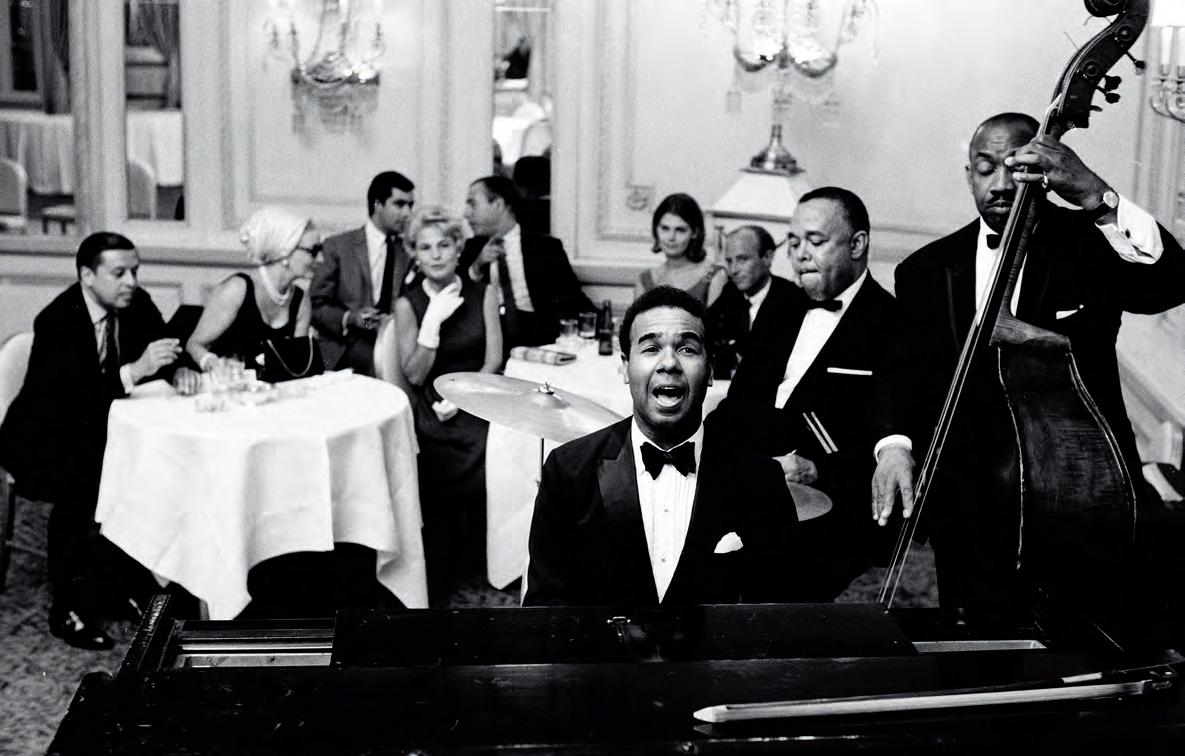
The legendary musician ruled the Carlyle hotel’s social scene for years with his songs. Constance C.R. White revisits the man behind the music.
obby Short decided to turn pro after he played the swank Palmer House in Chicago. He was 10. A precocious, cherub-cheeked man-child, he’d been singing and playing the piano by ear since he was four years old.
From the Palmer, Short would go on to perform for four presidents, numerous celebrities, countless society blue bloods, and anyone who happened to want to be wrapped in a gossamer cocoon of urbane luxuriance, if only for one night. He crooned reassuring American standards in a jazzy, polished, honey-soaked voice that made you think of money, old money.
Frank Sinatra, Warren Beatty, Lena Horne, Liza Minnelli, Angela Lansbury, Jack Lemmon, Eartha Kitt, the Duke and Duchess of Windsor, they all came to Short to be romanced.
AS AN ADULT, HE WITHSTOOD RACIAL SLURS AND MORE THAN ONCE WAS REF USED ACCESS TO VENUES HE OR HIS FRIENDS PERFORMED IN.

Short’s dazzling, seven-decade career took him to the White House and across the country to Frolics Cafe, the famed Apollo Theater, Café Gala in Los Angeles, and clubs in Las Vegas, London, and Paris. He eventually landed, in 1968, at the Café Carlyle on Manhattan’s Upper East Side, where he remained in residence for 36 years.
Fans became friends. Jackie O. first heard him at a small, obscure New York City restaurant, Short said. Thereafter, the former First Lady watched him at the Carlyle. Pat Buckley, Nan Kempner, and Gloria Vanderbilt, social butterflies with considerable wingspans, were regulars.
Short’s popularity extended beyond entertainment. He palled around with designer Fernando Sánchez, Henri Bendel’s Geraldine Stutz, Saks’s Helen O’Hagan—sometimes with her companion, the iconic actor Claudette Colbert—and writers Rex Reed, Dorothy Kilgallen, and Henry Van Dyke.
He also counted as friends a who’s who of groundbreaking Black entertainers from the ‘50s and ‘60s: Horne, Josephine Premice, Diahann Carroll, and Fredi Washington. Short wrote not one but two autobiographies, such was the sustained interest in the last of the great supper-club troubadours. The first, Black and White Baby, came in 1971, followed by 1995’s Bobby Short: The Life and Times of a Saloon Singer.
“We’re saloon singers,” he said to Horne. She’d often come with her husband, Lennie Hayton, the noted conductor/arranger, to watch Short. After-
wards, the three of them would retire to the couple’s apartment or remain after the show, singing, drinking, and playing piano.
He was one of Premice’s oldest friends, said the actor-singer’s daughter: producer, writer, and socialite Susan Fales-Hill. “I grew up my whole life going to see him at the Carlyle. He was a wonderful entertainer. It takes genuine talent to hold a room spellbound with just a piano and his voice.
“[Uncle Bobby] was very private,” remembered Fales-Hill. “But he performed with a lot of emotion. When he performed, you always left feeling good.”
Short almost certainly faced challenges. He was a child worker controlled by adults and described toiling long hours while in school, performing for a cup of cocoa. As an adult, he withstood racial slurs and more than once was refused access to venues he or his friends performed in. But he never lingered on these abuses. He wrote, “I am a negro who has never lived in the South, thank God, nor was I trapped in an urban ghetto.”
With derision, some have observed Short’s success with white audiences and the ruling class as indication of his desire to be white. But the truth was, he was a Black man navigating what W.E.B. Du Bois described as the “double consciousness.” “He was this incredible stoic,” said Fales-HillI. “I remember thinking, whatever horrors he had been through in his life, for him, he seemed to be saying, he made it through them.”
Short was very much in touch with his African American roots. “He was beloved by high soci-

ety—Nan Kempner adored him, Pat Buckley adored him—but he was always very grounded in who he was,” Fales-Hill points out. The parties he held at his Sutton Place apartment “were always very integrated” with white guests and Black guests like Carmen de Lavallade, Harry Belafonte, Carroll, and Premice.
When Fales-Hill married her husband, finance executive Aaron Hill, in 1997, Short, she recalled, had work that day. “I think one of the reasons he made a point of making it to my wedding is because he was so proud that this young Black woman was marrying this young Black man.”
As a performer, Short’s musical selections leaned toward the romantic: “Love Is Here to Stay,” “I’m in Love Again,” and “You’ve Got That Thing.”
He was best known for his interpretations of the Great American Songbook by writers like Cole Porter and Irving Berlin, but also performed Fats Waller, Thomas A. Dorsey, James Weldon Johnson, and J. Rosamond Johnson.
Always dapper, he was partial to a cashmere sweater off duty and a tux and bow tie at work, a jaunty side part in his jet-black hair. As a child, he wore white tails.
Robert Waltrip Short was born in Danville, Illinois, on September 15, 1924, the ninth of 10 children. His parents, Rodman and Myrtle Short,

IN
1980, VANDERBILT SUED THE EXCLUSIVE RIVER HOUSE APARTMENTS, ASSERTING THAT THEY BLOCKED HER PURCHASE OF A $1.1 MILLION CO-OP BECAUSE THEY WERE AFRAID SHORT WOULD MOVE IN WITH HER.

were poor, the former a Kentucky coal miner and the latter a maid. The money he made as a schoolage entertainer helped the family budget.
In later years, his work—which included numerous albums, commercials (Charlie perfume, anyone?), and TV—afforded him a life of material ease and luxury.
When not at Café Carlyle, Short performed short gigs elsewhere or decamped to his stunning, mountainside home in Mougins, France, which he named “Villa Manhattan.” It was shouting distance from Saint-Paul-de-Vence, home to Simone Signoret, James Baldwin, and Pablo Picasso.
Van Dyke visited Short there just months before the singer died of leukemia on March 21, 2005, in New York. Short never married, his love life a source of speculation, nor did he have children, though he adopted one of his nephews. It was long-rumored that he dated Vanderbilt. One of the home’s bedrooms was named the Gloria Vanderbilt Room, Van Dyke wrote. In 1980, Vanderbilt sued the exclusive River House apartments, asserting that they blocked her purchase of a $1.1 million coop because they were afraid Short would move in with her. She vacationed at his Côte d’Azur home, as did Premice and others. I asked Fales-Hill if the rumors were true. She claimed she had no knowledge of such a relationship.
Short’s impact on entertainment is impossible to measure. “He’s one of the legendary performers who made the Carlyle Café the Carlyle,” declared Allal Gogo, Café Carlyle’s general manager. “There are a lot of regulars who still come into the Carlyle because they want to remember the memories of Bobby.”
“I sketched many of my collections there,” recalled designer Zang Toi, who lives across the street from the Carlyle. He first saw Short perform in 1998. “I kept going back to his performances for the feel-good vibe that’s gorgeous and glamorous.”
Short’s dapper image is painted on the Carlyle’s wall. This fall, the storied hotel plans to honor what would be Short’s 100th birthday. You’ll be able to order his favorite dish: mashed potatoes, truffles, and chicken. After, wash it down with Bobby’s Manhattan made just the way he liked it—with rum, instead of whisky.
The French style icon and Rouje fashion designer has been dubbed “the Paris girl personified.” Damas is mom to a toddler; debuted her first store in the U.S.; and stars in the upcoming Disney+ series Kaiser Karl, with Daniel Brühl as Karl Lagerfeld. Peter Davis chats with the woman GQ called “the coolest, most beautiful French girl in France right now.”

Congratulations on becoming a mother! Would you do a Rouje line pour les enfants?
I love to dress my kid, but I’ve never thought about designing a children’s line. Although my first fashion memory is my mother, who did all the clothes for my sister and me when we were little. I remember embroideries on corduroy, lace collars, the color. Unfortunately, we didn’t keep any of these outfits.
Having a son must have changed your fashion-forward influencer lifestyle. Being a working mother changes your life. Obviously, it had also some evolution when it comes to my style, which shows in the Rouje collections. I started to wear sneakers during my pregnancy and added them to Rouje. Same with bags. I used to wear only small bags. Now we design bigger bags as well, like the “Mum,” which we launched last fall.
The new Rouje boutique in New York is super chic!
I wanted to open a store in New York for a long time, but then Covid happened, and we needed to postpone. I was looking for a space in SoHo and we were lucky to find this gorgeous space on Broome Street. I’ve asked my friend Nina Koltchitskaia to work on two murals and together with my architect, Maxime Bousquet, we developed the interior design: a very cozy, elegant space with a lot of air and light.
You now have eight stores around the globe.
I’ve always seen Rouje more as a lifestyle brand, so opening stores and making Rouje a physical experience is very important— being able to touch the fabrics, trying on the clothes directly. I don’t want to open too many stores, but a couple of flagships in cities like Los Angeles or Berlin is something I’m looking into.
Tell me about playing Paloma Picasso in Kaiser Karl.
We finished filming last summer. I was honored to portray such an iconic personality. I’ve learned so much about the Parisian fashion world in the ’70s. It was a very enriching to work with costume designer Pascaline Chavanne, who found the most incredible vintage costumes, and Daniel Brühl, who is astonishing as Karl Lagerfeld. I haven’t met Mrs. Picasso yet—I would be very nervous and intimidated to meet her. I don’t own any of her jewelry, but my mother gave me her Picasso bag from the ’90s as a lucky charm.
How do you manage your huge Instagram following?
I never share private things on social media, it’s not my thing. I also cut off my phone when I’m home to be able to switch off. Everything is a question of balance. Social media is part of the work, but it’s important to keep in mind the difference between work and real life.
You are credited with bringing “French-girl style” to America.
To me, New Yorkers have a very inspiring style. Everybody asks me about “French-girl style,” but personally I’m more inspired when traveling, be it NYC, London, or Tokyo. I think it’s the freshness of things we don’t see in our everyday life which attract our eyes.
The current Costume Institute exhibit at the Met is all about female designers. Do you have any favorites?
Right now is a very interesting moment in fashion, as more and more women designers are shaping the landscape, be it Maria Grazia Chiuri at Dior or Maryam Nassir Zadeh and Paloma Wool. There are many designers I admire, like Diane Von Furstenberg, Vivienne Westwood, and Agnès b. They used their voices to be engaged in other topics than fashion. You get compared to Jane Birkin a lot.
It’s of course very flattering to be compared to women like Mrs. Birkin, but to me all these women are more than just a look or a way to dress. It’s their lifestyle and what they stand for that is inspiring. Style-wise I always liked American actresses from the early 2000s, like Kirsten Dunst or Chloë Sevigny. Sofia Coppola is also iconic. I get inspired by many women close to me, my mother, my friends.


ATLANTIC CADILLAC BAY SHORE, NY
BICAL CADILLAC BROOKLYN, NY
BROGAN CADILLAC TOTOWA, NJ
BUZZ CHEW CADILLAC SOUTHAMPTON, NY
CADILLAC OF GREENWICH GREENWICH, CT
CADILLAC OF MAHWAH MAHWAH, NJ
CADILLAC OF MANHATTAN NEW YORK, NY

CIOCCA CADILLAC FLEMINGTON, NJ
CROWN CADILLAC WATCHUNG, NJ
D’ADDARIO CADILLAC SHELTON, CT
EMPIRE CADILLAC OF LONG ISLAND CITY WOODSIDE, NY
GOLD COAST CADILLAC OAKHURST, NJ
GRAND PRIZE CADILLAC NANUET, NY
HUDSON CADILLAC POUGHKEEPSIE, NY
INGERSOLL CADILLAC OF DANBURY DANBURY, CT
JOHNSON CADILLAC BUDD LAKE, NJ
KING O’ROURKE CADILLAC SMITHTOWN, NY
MALOUF CADILLAC NORTH BRUNSWICK, NJ
MCGUIRE CADILLAC WOODBRIDGE, NJ
CADILLAC
OPEN ROAD CADILLAC FLORHAM PARK, NJ
PAUL CONTE CADILLAC FREEPORT, NY
PEPE CADILLAC WHITE PLAINS, NY
PINE BELT CADILLAC OF TOMS RIVER TOMS RIVER, NJ
SARANT CADILLAC FARMINGDALE, NY
TRINITY CADILLAC ENGLEWOOD CLIFFS, NJ UNITY CADILLAC NEWBURGH, NY